Plant Physiology
Plant Structure
Cell division → cell enlargement → cell differentiation. Plants may continue to grow throughout life due to dividing cells.
Shoot apical meristem: tip of the shoot gives rise to cells of the stem and leaves
Root apical meristem: tip of the root gives rise to cells of the root
Lateral bud meristem: at the nodes of the shoot, gives rise to lateral stems (branches)
Internode: region between two nodes, leaves grow out of nodes
Phyllotaxis: variation in leaf arrangements
Lateral root meristem: points along the root gives rise to lateral roots
Growth from meristems is called primary growth → lengthening
Embryophytes (land plants): share traits derived for surviving on land absent in algae
Nonvascular plants (bryophytes) and vascular plants (tracheophytes)
Vascular plants are non-seed or seed (fern or gymno/angiosperms)
Alternation generations: diploid cells (2N) in one generation, and then the next one has haploid cells (1N). May have different metabolic dependencies.
Diploid plants meiosis produces spores (sporophytes), form gametophyte. Once haploids combine the have fertilization create a zygote.
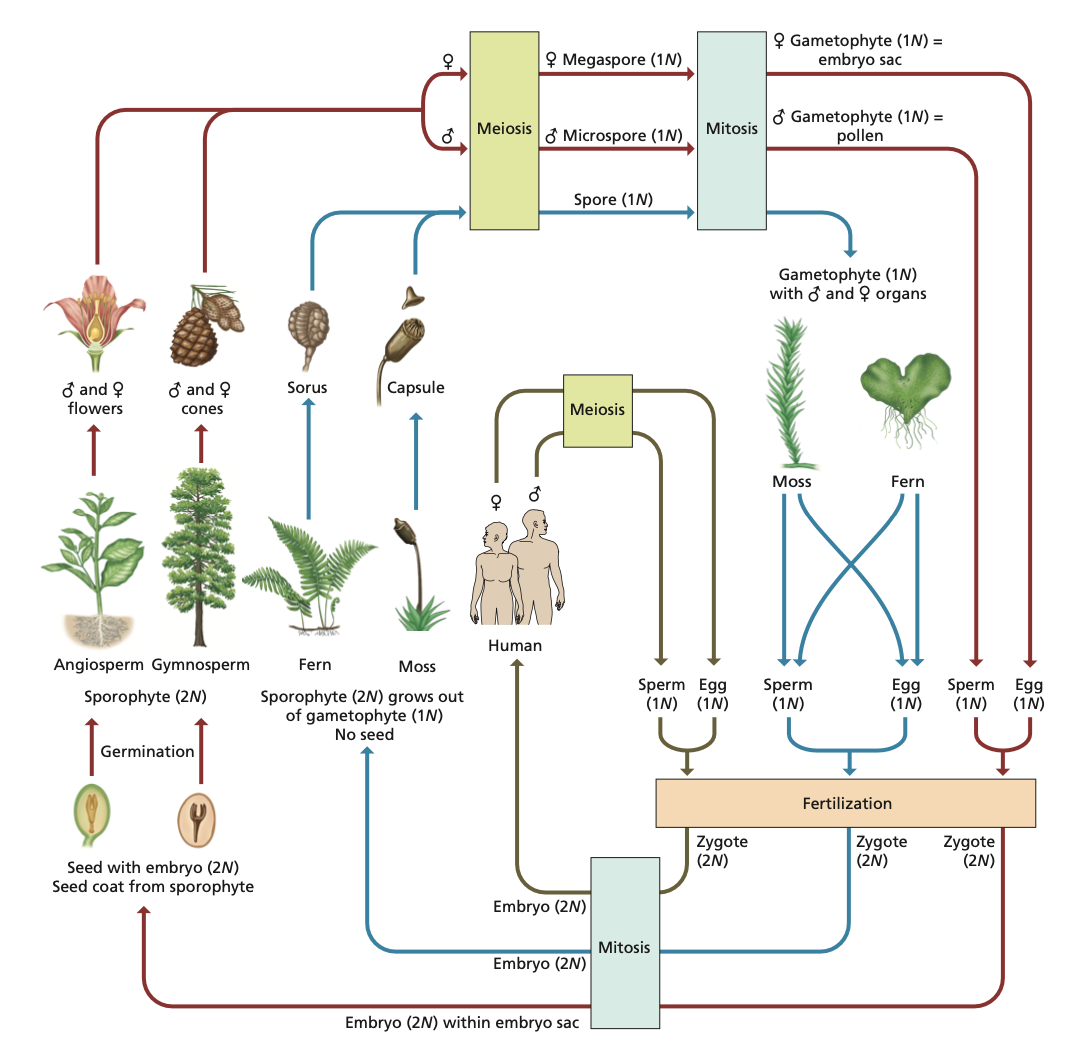
Sporophyte generation (diploid) and gametophyte generation (haploid)
Different spores:
Megaspores: develop into female gametophyte
Microspores: develop into male gametophyte
Angiosperms
Angiosperms are divided into two major groups. About 370 000 known species, 17 000 unknown species.
Monocotyledons (monocots): One cotyledon (seed leaves) in the embryo
Eudicotyledons (eudicots): Two cotyledons (seed leaves) in the embryo
The leaves, stems and roots of monocots and some eudicots have only primary growth.
Gymnosperms
They undergo secondary growth in the stems and roots. 800 species. Largest group is conifers.
Vascular cambium and cork cambium: causes secondary growth behind the meristems. Bark.
Indeterminate growth: plants growth in roots and shoot that occurs throughout their lifetime. no clear stop in site.
Determinate growth: growth stops at a particular point. mostly in animals, some parts of plants such as leaves, fruits, and flowers display such characteristics.

Monoecious: species has flowers that produce both male and female gametophyte of a single flower
Dioecious: species that has male and female appear on separate flowers.
Conifers produce female cones (megastrobili) (which are usually higher on the plant) and male cones (microstrobili)
both only produced by few cells
Plant cells and tissues
Plants cells have plastids (chloroplasts), a cell wall, and a large central vacuole.
Primary cell wall - found around all plant cells
All plant cell walls contain cellulose and other complex polysaccharides, providing it tremendous mechanical strength. Even so, it is able to stretch as well.
Secondary cell wall: in some plants, once cell expansion has ceased, this thicker cell wall is made. Contains lignin (provides greater strength). No further cell wall can occur once this is present.
Middle lamella: space between two adjacent cells in a region that helps cement them together.
Plasmodesmata: connects cytoplasm of adjacent cells. Tubular structures. Intercellular movement of proteins, nucleic acid and macromolecules.
Primary: forms during cell division
Secondary: forms after cells have divided
Core of each is desmotubule. Endomembrane structure derived from both adjoining cells.
We divide the plant into two regions
Symplast: region of the plant body enclosed by plasma membrane (interior of plant cells). Includes plasma membrane and cytosolic connections (plasmodesmata) between adjacent cells. Movement through plasmodesmata is called symplasmic transport.
Apoplast: consists of the region outside the plasma membrane (intercellular air space). Transport through the permeable cell wall space outside the cells is called apoplastic transport.
Size exclusion limit: restriction on size of molecule that can transport via symplasm, varies with cell type, environment, and developmental stage.
Parenchyma tissue: composed of parenchyma cells. Thin primary wall and large central vacuole. Wide range of functions in the plant, depending on their location, from food storage to carrying out photosynthesis.
Collenchyma tissue: composed of collenchyma cells. and is often present in young actively growing parts of the plant requiring mechanical support. Parenchyma-like cells, often more elongated and thicker which provides mechanical support while still allowing for cell expansion in these growing parts.
Sclerenchyma tissue: this tissue is found in mature plant parts and also provides mechanical support. Thick secondary cell wall. Dead at maturity. Two types of cells. Fibers (elongate cells, vascular tissue), and Sclereids (more variously shaped cells, common in seed coats).
Xylem tissue: Conducting tissue. Vascular tissue type. Has a primary form. Responsible for water and mineral nutrients from the root to the shoot. In gymnosperms, the major water conducting cell type is the tracheid. In angiosperm, the major water conducting cell type is vessel elements. Both withstand extreme negative pressure (tension).
Tracheid: elongate, hollow, dead cells in xylem. The plasma membrane, nucleus, and cytosolic contents have been lost. Has pits in their walls - movement from one cell to another.
Vessel elements: hollow dead cell at maturity. form a continuous hollow tube for efficient water conduction. Larger over evolutionary time. Lower water resistance, breaking down walls.
Phloem tissue: Conducting tissue. Primary form. Responsible for the movement of products of photosynthesis (sucrose) from leaves to stems, roots, flowers, and fruits. Major conducting cells are the sieve tube elements. Cells from long tubes (sieve tubes) for conduction of substance. Contain cytosol and some organelles but lack nucleus. Movement is aided by pores in the end walls between cells. Sieve plates (end walls). Companion cells, dense cytosol and have regulatory role in phloem transport. Secondary phloem works like primary phloem and is derived from vascular cambium.
Tissue systems
Dermal tissue system: provides an outer covering of the plant (epidermal or corky tissue)
Vascular tissue system: specialized for the transport of substances from one part of the plant to another (xylem and phloem). Conducting, parenchyma cells. Thick-walled fibers.
Ground tissue: filling tissue between dermal and vascular tissue. Includes pith and cortex of primary stems and roots, and the mesophyll in leaves.
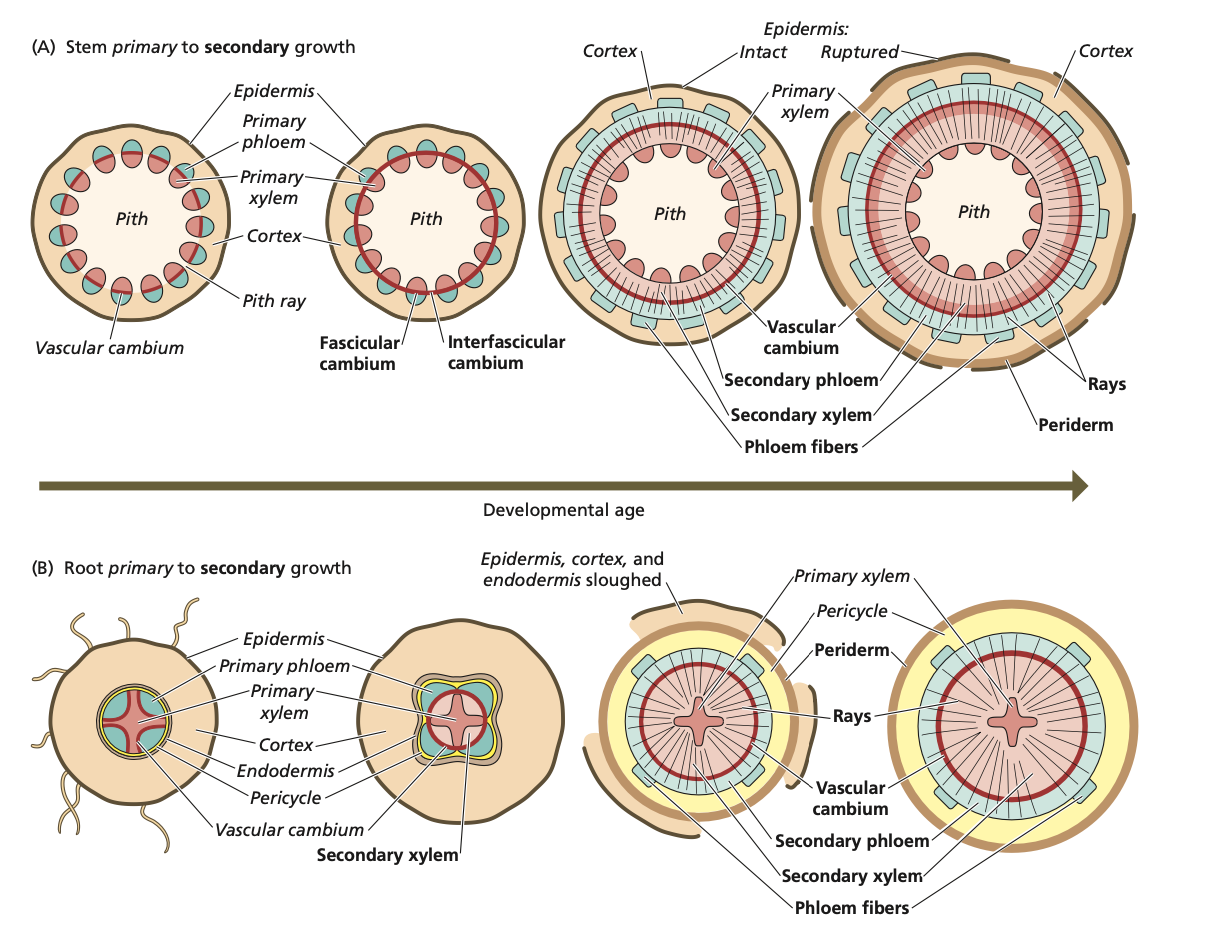
Plant vegetative organs
Primary plant axis: main stem and taproot, vertical. Most leaves instead grow laterally. Flattened leaf blade. Adaxial surface (upper) surface of the leaf faces towards the stem, and the abaxial (lower) leaf surface faces away from the stem.
Root: has a root cap that has cells maturing into parenchyma cells toward the tip, and it works to protect the root apical meristem as it pushes its way through the soil. The root cap is a structure unique to root apical meristems
Zone of cell division: root apical meristem and the cells immediately behind it undergo rapid cell division. Can begin to see blocking out of dermal, vascular and ground tissue → mature epidermis, xylem and phloem, and the cortex and pith
Zone of cell elongation: in this zone, cells produced by the root apical meristem undergo a period of rapid growth in length (cell elongation)
Zone of cell differentiation: now fully expanded cells differentiate into particular cell types. Proceeding from the outside toward the middle of the root there are different parts -
Epidermis: outer layer of cells, dermal tissue system of the root. Many epidermal cells grow long extensions called root hairs. They increase the absorptive surface of the root, aiding uptake of water and minerals
Cortex: region usually made up of thin-walled parenchyma cells often involved in the storage of food within the root
Endodermis: single layer of cells, the cell walls of which contain suberin (called the casparian strip), which provides a barrier preventing any further movement of water or solute within the apoplast.
Sieve cells (gymnosperm), and sieve tube elements stack and create sieve tubes (angiosperms). Made in phloem cells
Stele: the central region of the root contains the vascular tissue system. Pericycle is the outermost layer(s) of cells, may become meristematic. Xylem tissue and phloem tissue, differs in arrangement between monocots and eudicots. Monocots has a central region of the stele, additional ground tissue called the pith.
Pericycle: root branch meristem - where lateral roots arise from.
Stem: There is another blocking out of three tissues. Epidermis, the ground tissue region (cortex and pith), and the vascular tissues (xylem and phloem).
Vascular tissue of the stem transports substances. Made into strands called vascular bundles - xylem toward the center of the stem and phloem is toward the outside. Arrangement may differ in monocots and eudicots. Vascular bundles are arranged in a single ring in eudicots, and are scattered in monocots. Pith found in both, look different though.
Axillary buds: meristems that develop at the node of the leaf axil - the region between the lead and the shoot. Become apical meristems of branches
Secondary growth of stems and roots:
Vascular cambium: a single layer of cells that develop between primary phloem and xylem. Secondary phloem (outside) and secondary xylem (inside) (wood start to grow. Provides additional conducting tissues to the plant body as its roots and stems become more extensive.
Rays of parenchyma cells: cells within xylem and phloem tissues are arranged like the spokes of a tire.
Cork cambium: single layer of cells formed in cortex or outer phloem - produces cork cells outside roots and stems. Abundant suberin which is a barrier to water and gas exchange. Thick cork tissue replaces the protective function of the epidermis which dies during secondary growth.
Eudicots may be classed as herbaceous plants or woody plants based on how they display secondary growth. Vascular cambium functions for only a few months, secondary growth is usually negligible. Trees and shrubs live for many years, displaying large amounts of secondary growth.
The leaf: contains epidermal cells on upper and lower surfaces. Upper covered in waxy layer (cuticle) - waterproofing substance
Palisade mesophyll: elongated cells found below the upper epidermis
Spongy mesophyll: irregular shaped cells found below the palisade mesophyll. Loosely packed, resulting in a large volume of intracellular air space within this part of the leaf
Stomata: gas exchange for photosynthesis occurs. open and close as guard cells change shape.
Growth points are 4 primary meristems and 2 secondary meristems.
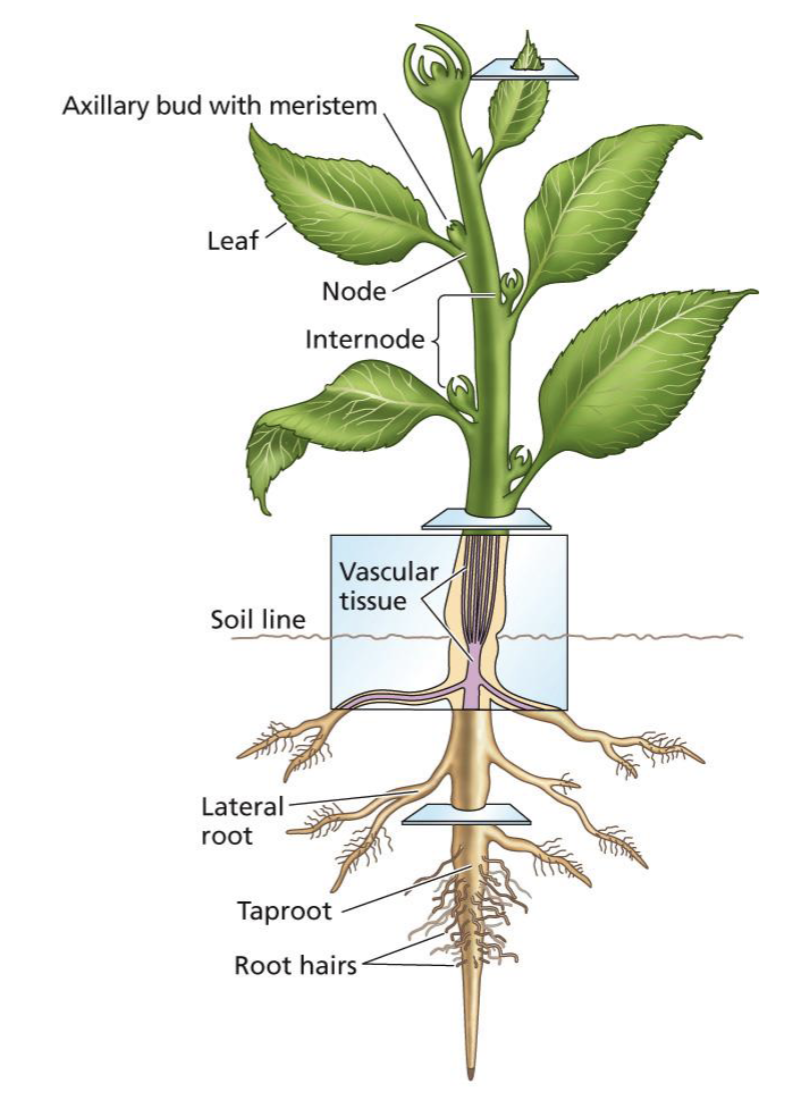
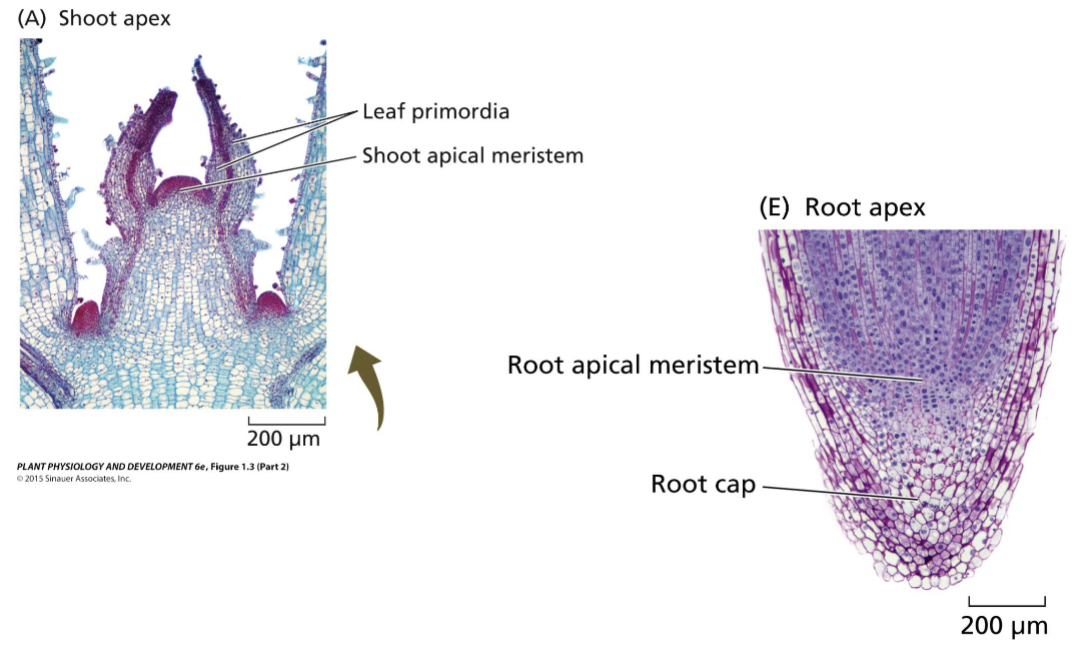
Epidermal cells look like a quilted blanket and a honeycomb
Ground tissue: parenchyma cells
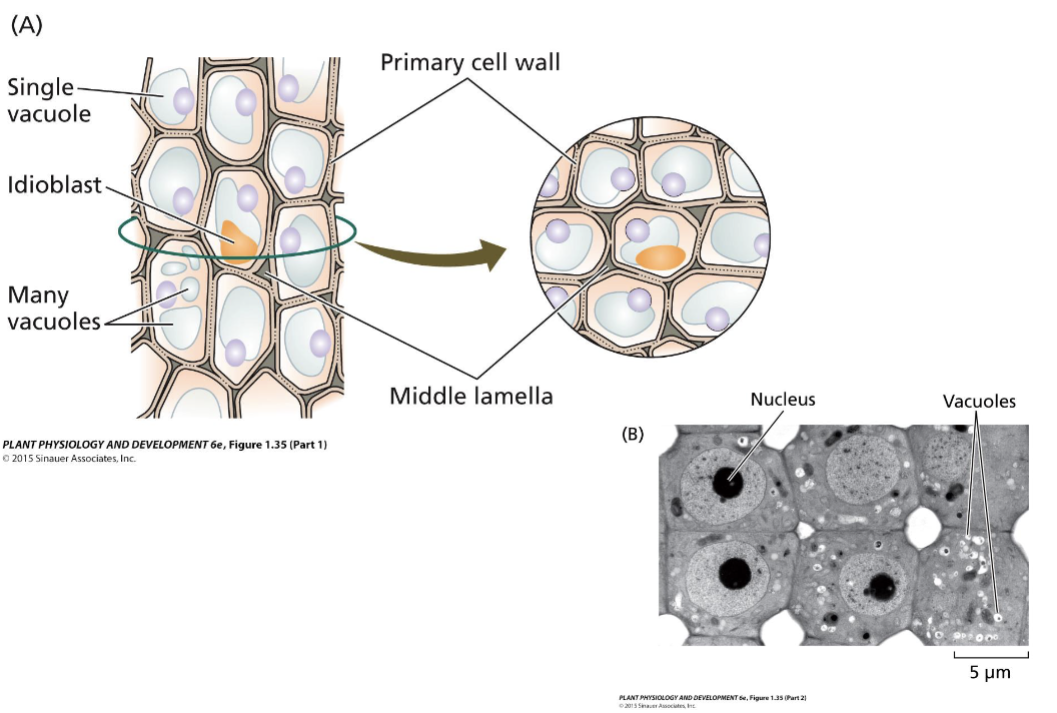
A ton of more images - review, maybe print them
Cell functions
Heterochromatin compact, euchromatin open
Nucleolus generates ribosomes
rRNA protein synthesis
Signal peptide and signal recognition particle - deal with opening up membrane
Exocytosis: allows forward anterograde trafficking of biosynthetic cargo and membrane from the site of synthesis, ER and Golgi apparatus.
ER communication network - secretory protein synthesis. Rough ER has the ribosomes bound. Smooth ER makes membrane phospholipids.
Peroxisomes: detoxify ROS with catalase. Glyoxysomes deal with beta oxidation of fatty acids.
Chloroplast:
Thylakoids stack → granum
Adjacent grana are linked by unstacked membranes called stroma lamellae.
Compartment surrounding thylakoids is called the stroma
Chromoplasts have cartenoids - orange, red yellow pigments.
Prolamellar bodies: semicrystalline tubular arrays of reorganized thylakoid membranes in etioplasts (germinated seedlings kept in dark develop these)
How Plants Function
Plant kingdom
Non-vascular plants: lacks xylem and phloem (moss)
Vascular plants: Seed plants, embryo life and nutrients give life.
Gymnosperm: about 800 species (conifers). Do not produce flowers. Lots of useful materials.
Angiosperms: more than 120 000 species left. Produce flowers.
Monocotyledons (embryo with single seed leaf)
Eudicotyledons (embryo with two seed leaves)
Seeds are a vessel containing an embryo and stored starch, protein or lipid that acts as a source of nutrient during seed germination.
Green algae is the closest related non-plant species to plants.
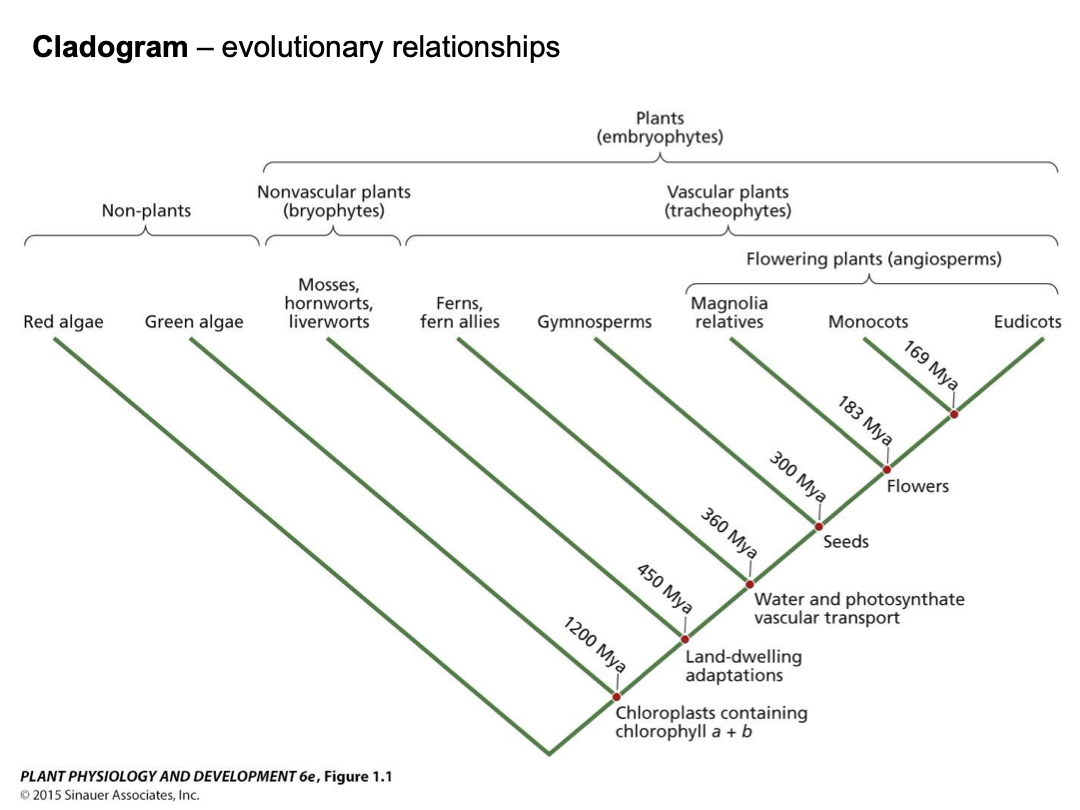
The additional events are listed as important - chloroplast with chlorophyll a + b, land-dwelling adaptations, water and photosynthate vascular transport, seeds, flowers.
Unique features of the plant body and the plant cell
Plants cells are eukaryotic. They have Plasma membrane, nucleus, cytosol, mitochondria, as well as some unique features like cell wall, large vacuole and plastids. Lipids and protein composition may differ between membranes, but they exist. Phospholipids in some.
Phospholipids are made up of a head group and fatty acid chain 1 and 2. Membrane is a layer of lipids, mono or bilayer. Middle is hydrophobic, cannot interact with water. Head group is hydrophilic. Head group, choline, phosphatidylcholine attaches on glycerol. Lipids can be very different may be a glycolipid. Where you replace what’s on the side.
Triglycerold (TAG) is the main storage lipids.

Plant cell walls
Composed of complex polysaccharides - but also other constituent.
Middle lamella - region “cementing” one cell wall to its neighbour. Pectin holding in place. Staple, don’t move around.
Plasmodesma: physical connection between the two cells. Trigger defense. Communicate with each other.
Endoplasmic reticulum: ER is also connected. ER is the blue. Structure very extensive.
Only the pass through region matters. Pink desmotubules lining up the proteins. Spoke protein is a filamentous protein which connect and by interacting, there is a bridge between plasma membrane.
Unlike animals, no cell migration - therefore development is very dependent upon plane of cell division and direction of cell expansion
1o cell wall: thin, typical of young growing cells, can stretch and expand
2o cell wall: found between PM and 1o cell wall. Thicker, stronger, can contain lignin for structural rigidity (wood). Simple pits prevent blocking of plasmodesmatal connections between cells. Mature cells.
Composition may differ between plants. Different thickness, stretch. Mutual divide is important in cell growth. As soon as plants establish secondary cell wall, they cannot stretch anymore.

Channels become smaller, animals cannot pass. Controls PM and ER interaction. Proteins holding in plasmodesma play role in size exclusion limit (SEL), lots of signals control size limit. size limit varies.

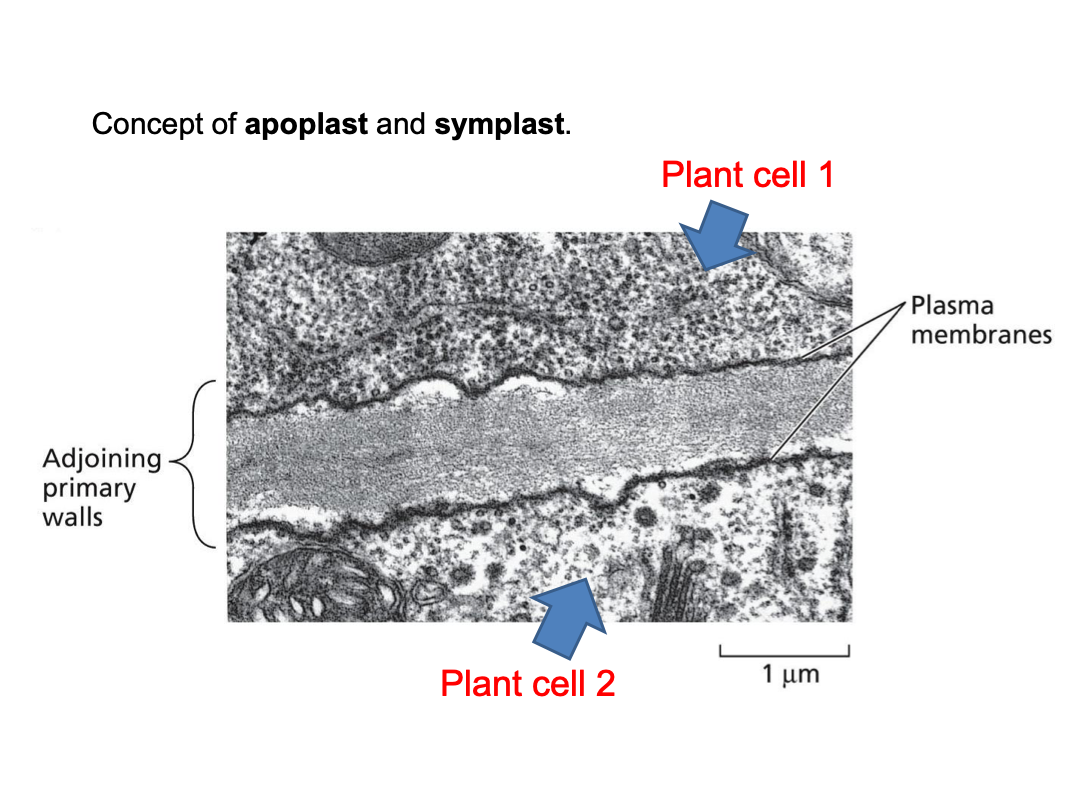
Weak bet. Amino lamella. Primary cell wall region. Middle lamella region.
Symplasts of adjacent plant cells can be physically connected due to the presence of plasmodesmata. Plasma membrane lines pores that connect adjacent cells and allow symplastic transport. Desmotubules do communication in ER. Cytoplasmic sleeve has variable SEL. Microchannels made by globular and filamentous proteins. SEL regulated by a wall collar (callose) and globular and filamentous proteins.
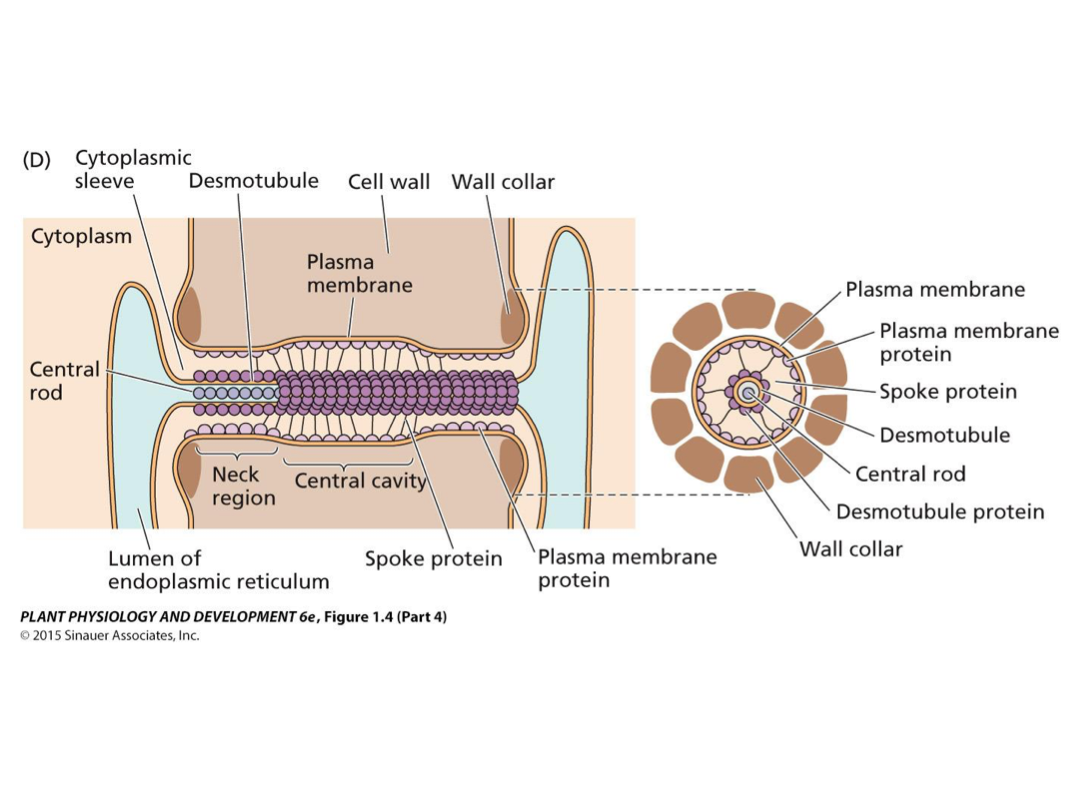
Shows plasmodesmata. ER and another ER. each is regional. Protein connecting ER and PM. Spoke and radial protein and collar regulate the channel. Wall collar has a specific type. Controls channel size - differing from plant to plant.
Only difference in everything is by hormones and synthesis. during subdivision (primary), they need to do something with the daughter cells. Plasmodesmata form after cell division. After cell division, there’s already a cell wall, too difficult to get through. Cells really need to locally digest cell wall.
Primary plasmodesmata - forms during cytokinesis, connections between clonally related cells.
Secondary plasmodesmata - form after cell wall deposition, requires localized digestion of existing wall between cells, allows communication between clonally unrelated cells. Cell walls are too difficult to get through. Cell really needs to locally digest cell wall
Pit fields - depressions in the primary cell walls where numerous plasmodesmata cluster. Secondary wall does not form over these fields, leaving pits in the secondary wall.
Plasma membrane - fluid mosaic model
Proteins are embedded in the bilayer and may move laterally depending on the fluidity of their membrane environment
Phospholipid bilayer - fatty acid can be different carbon length, even number. Cool temp makes things more fluid. Amphipathic. Unsaturated makes it more floor. Lower temp, plants more unsaturated, maintain fluidity.
Protein - integral (all the way through), peripheral (one side, attached to side covalently), anchored
Vacuoles: Single membrane bound (one bilayer), tonoplast - membrane for a vacuole.
Young cells have provacuoles and fuse together (from golgi), then provacuoles fuse. Vacuoles are 95% of total cell volume.
Turgor pressure - water enter the vacuole and can enlarge and it creates force to push against. Main driving force.
Vacuoles store water, inorganic ions, organic acids, sugars, enzymes, secondary metabolites (diverse functions)
Specialized functions: for nutrients in seeds, they cannot be directly used by plants
Primarily water uptake into vacuoles that drives cell expansion and generates turgor pressure
Specialized vacuoles: protein storage vacuoles and lytic vacuoles are abundant in seeds. During germination they fuse and proteases break down the proteins to provide nutrients for the young seedlings.
Senescence programmed death of plant organs → vacuoles release proteases, ribonucleases, glycosidases to degrade macromolecules to small molecules.
Mitochondria and Chloroplasts: Energy metabolism (respiration, photosynthesis), double membrane bound, specialized membranes. Endosymbiotic theory. Own DNA. Encoded by nuclear genes, protein synthesis in cytosol. semi-autonomous.
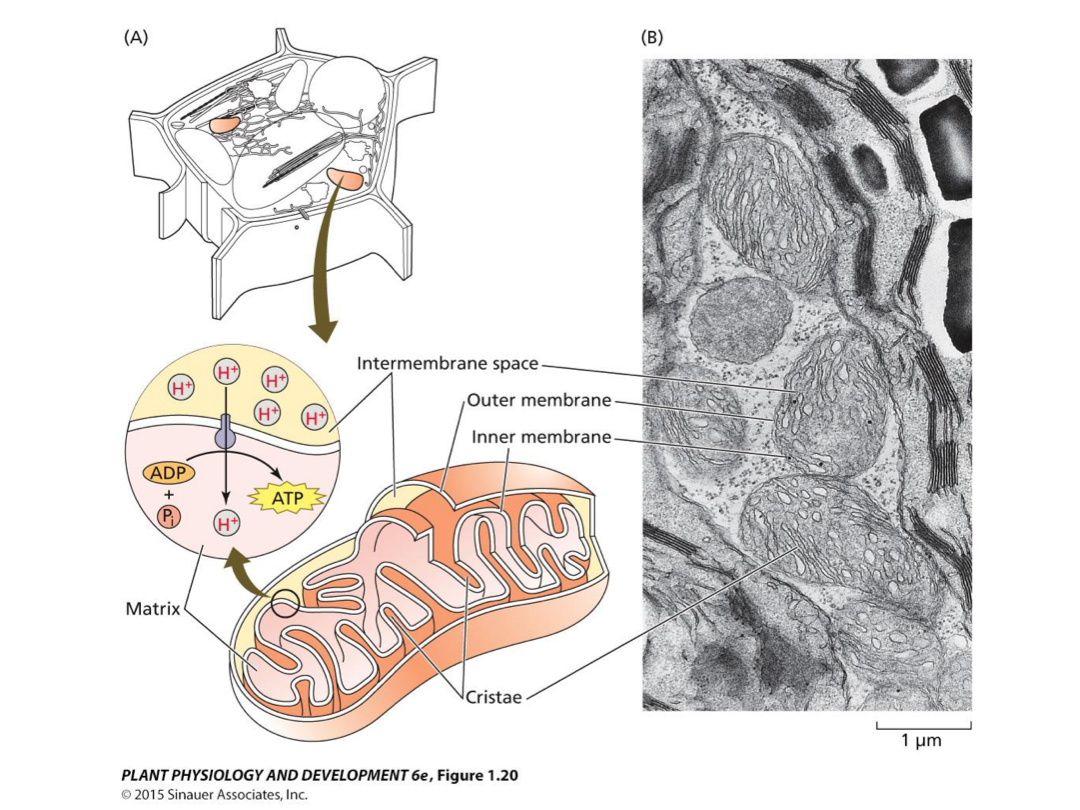
Each cell has multiple mitochondria (b). ATP generated and goes through membrane, create proton gradient.
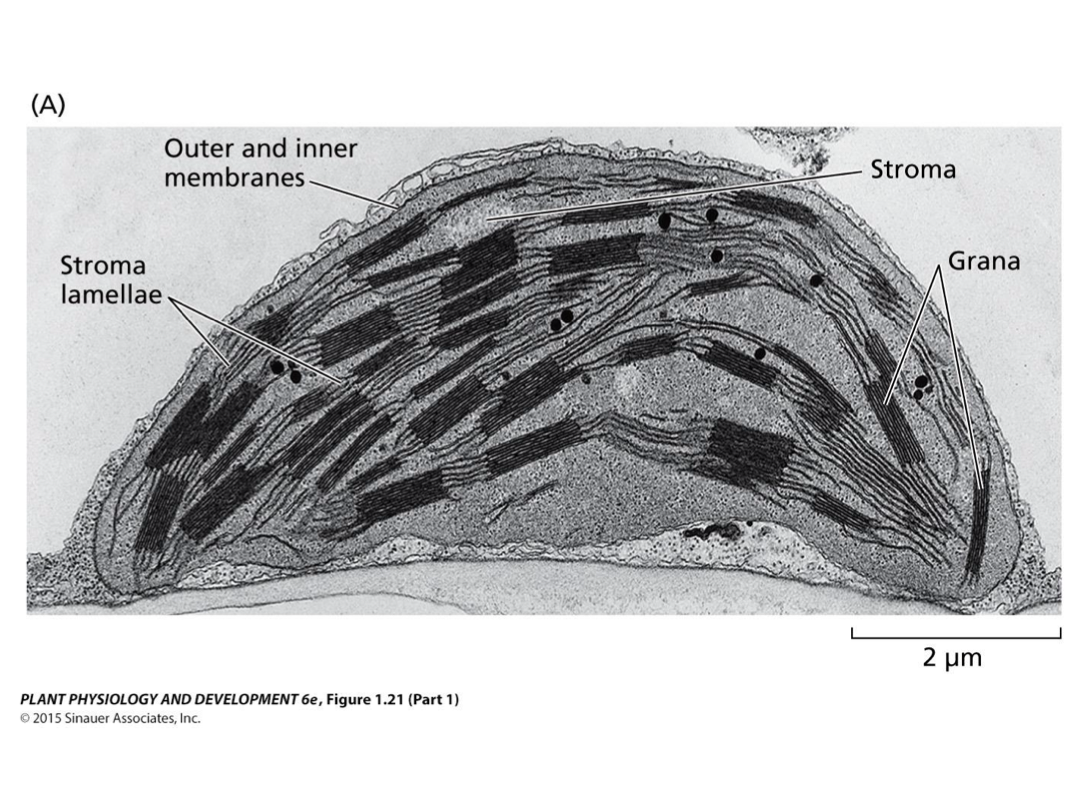
Electron micrograph image of chloroplast. Outer and inner membrane are closely related. Stacking thylakoid membrane called grana. Unstacked connecting two grana. Cytosol membrane divided by 2.
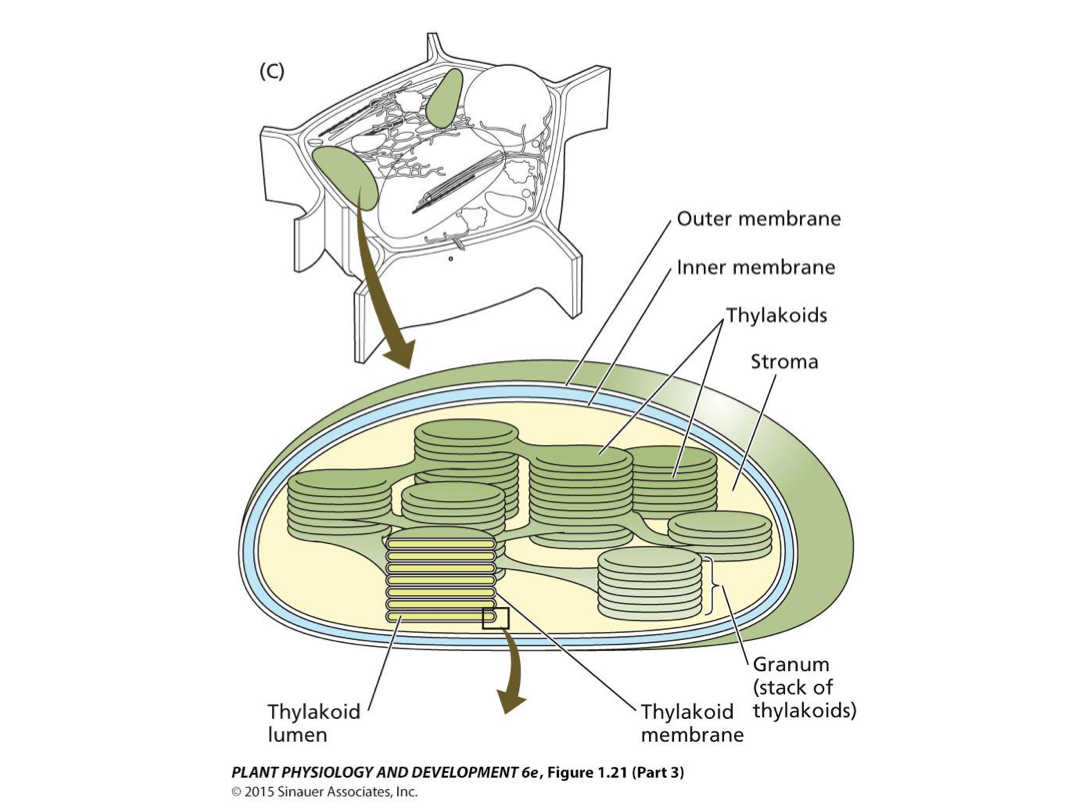
Unstacked is lamella. Lumen in there. Inner area known as stroma. Where does light reaction occur - thylakoid membranes. Dark reactions - stroma.
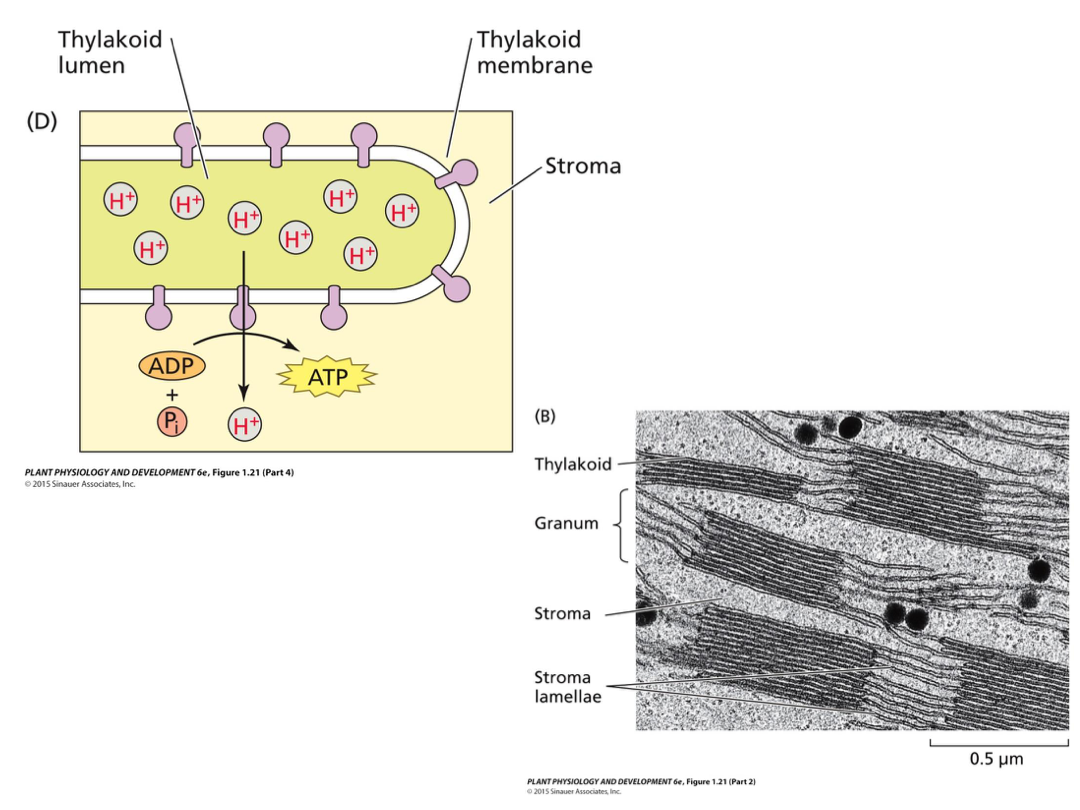
Thylakoid membrane, there’s lumen. Similar to mitochondria. Rely on the protein gradient.
Chloroplast is just one type of plastid - all double membrane bound organelles. Unlike most eukaryotic membranes, where phospholipids dominate the bilayer, plastid membrane. No phosphate, head group is galactose, digalactose, or sulfated galactose. Different plastid types develop from proplastids.
Plastids:
Pigmented plastids:
Chloroplasts: chlorophyll, photosynthesis
Chromoplast: carotenoid pigments, abundant in flowers, fruits
Non-pigmented plastids:
Amyoplast - starch-storing plastid abundant in storage tissues of shoot and root, potato tuber, seed, and root cap (gravity sensing)
They develop, starting as proplastids in young plant cells with little pigment. They begin developing with specific signals like seed germination in light, they start developing their chlorophyll, ready for photosynthesis in young mesophyll cells. Internal membrane is disorganized (prolamellar body) and the precursor to chlorophyll accumulates (protochlorophyllide). light signal → etioplast → chlorophyll. extended darkness → chloroplast → etioplast. Chloroplast can change to chromoplast (fruit) and amyloplast can become chloroplast (exposed root, potato tuber).

Internal structure
structure inside, thylakoid is not very extensive yet - early developmental stage
Etioplast - not like stacked structure, if it receives light it will become thylakoid
Microbodies: spherical, single membrane-bound, specialized metabolism.
Peroxisomes - involved in photorespiration in mesophyll cells. glycolate oxidation in this pathway produces hydrogen peroxide, a reactive oxygen species (reactive, potentially damaging). High levels of catalase breaking down H2O2. Single membrane. Uses rubisco to react with oxygen rather than CO2 which then uses CO2 to make sugar (3-PGA)
RH2 + O2 → R + H2O2 (RH2 is the glycolate)
H2O2 → H2O + ½ O2
Glyoxysomes - lipid-storing seeds, enzymes for glyoxylate cycle which converts triacylglycerols to sugar during germination.
Lipids need to be converted into carbohydrate to be used, the triglycerols has fatty acid attached.
lipid bodies have half of a bilayer. Synthesized in ER, half membrane bud off.
Half membrane contains a oleosin (protein) which recruits glyoxysomes to initiate lipid breakdown.
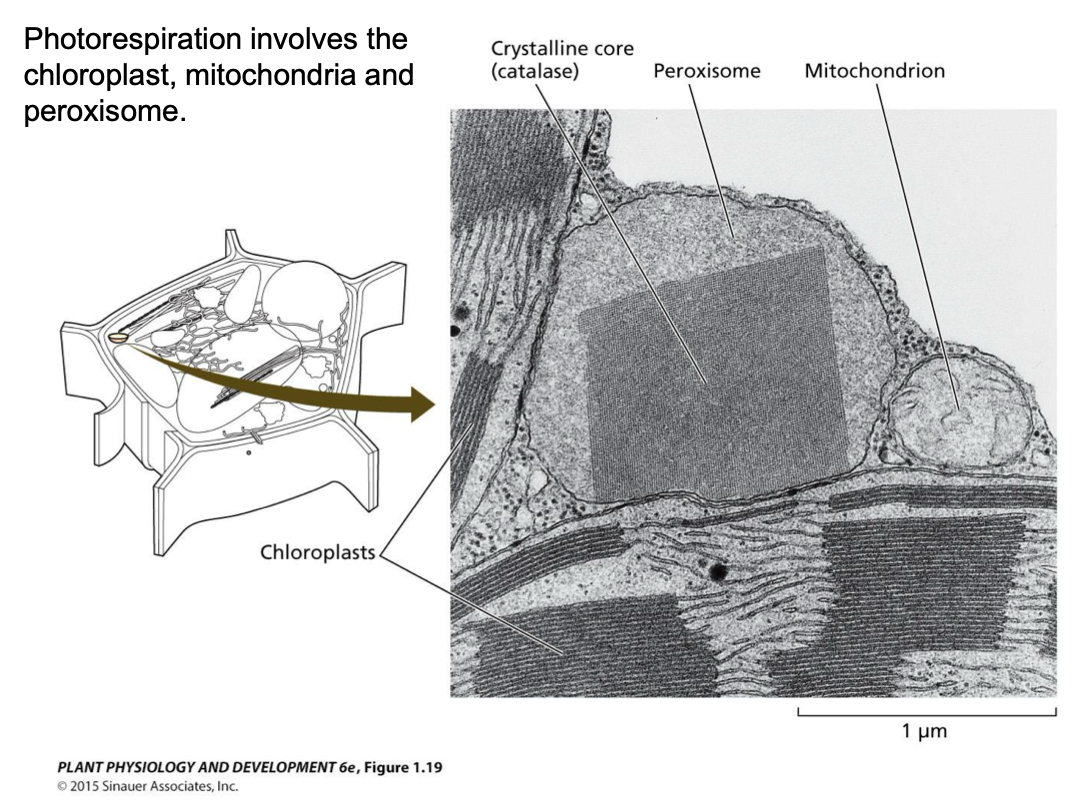
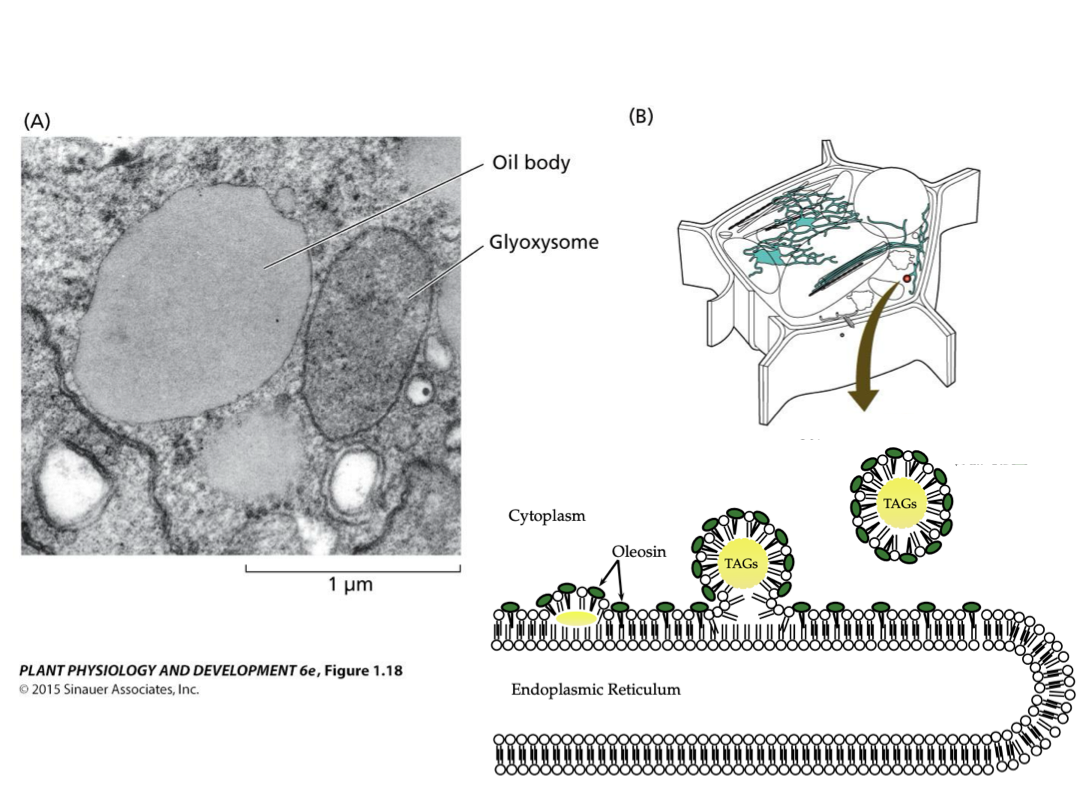
TAGs are synthesized within bilayer. Clustering a very large group. Only one phospholipid bilayer, lipid body is only half membrane. Oleosin can bring oxygen to body, they need to find lipid. Main function to convert lipids into carbohydrates.
Cytoskeleton: 3D network of filaments in cytosol that provides → organization, movement, mitosis/meiosis, cell division, cytoplasmic streaming, cell wall synthesis. Proteinaceous (actin, microtubules are the two main types of cytoskeleton) filaments that assemble and disassemble are a major part. Assembly is energy-dependent. Cytoskeleton is like a highway.
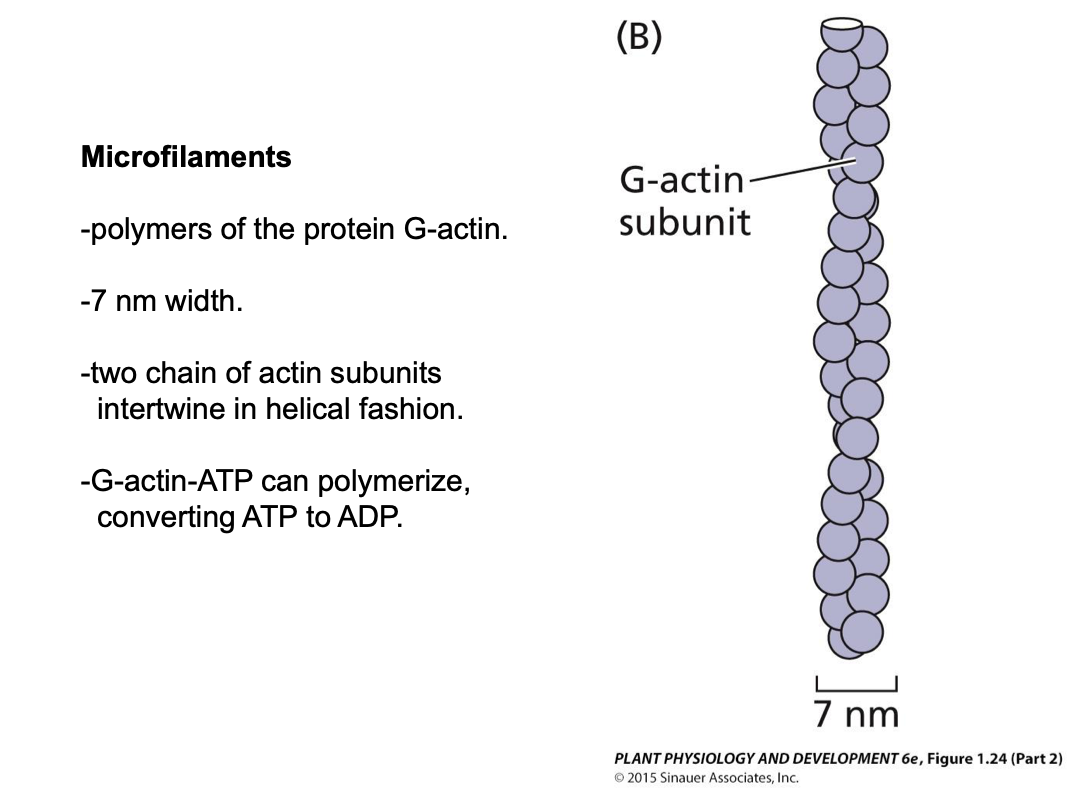
Subunit is the G-actin. Connect and form a string like structure. About 7nm, very tiny. Cell is very dynamically built up and demolished in the cytoskeleton. Can be elongated or shrunk. Created through polymerization. This requires ATP.
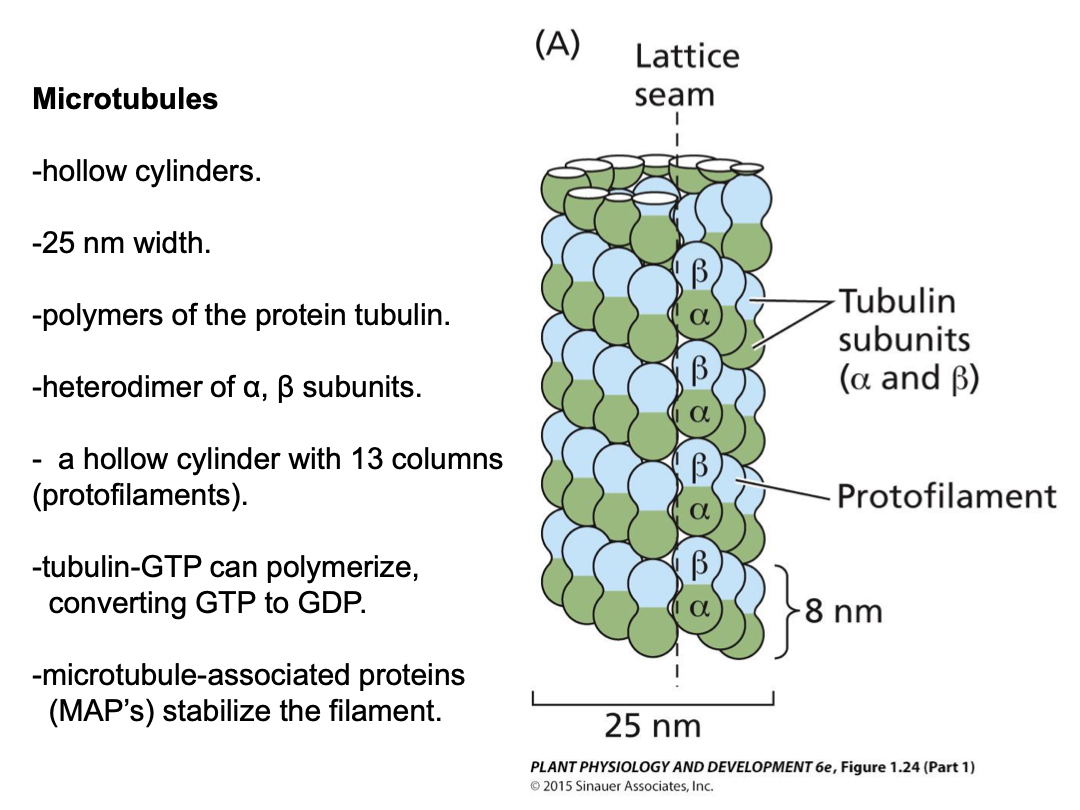
Single string has alternating subunits, forming a single string - protofilaments. Uses GTP to build up, not ATP.
Polymerization: building up the highway. Sheet-like positive end, curling into a tubule as the GTP is hydrolyzed.
Depolymerization: taking down the highway. Frayed positive end, with individual protofilaments separating and curling.
To move across the highway, we use a motor protein. Myosin for actin filaments, kinesin for microtubules. Similar structures. Head neck and tail regions. Walks along filament, head region uses ATP hydrolysis as energy source. Homodimer - specific red domain or teal domain on both sides. Neck region can walk along. Cargo domain, it can move across.
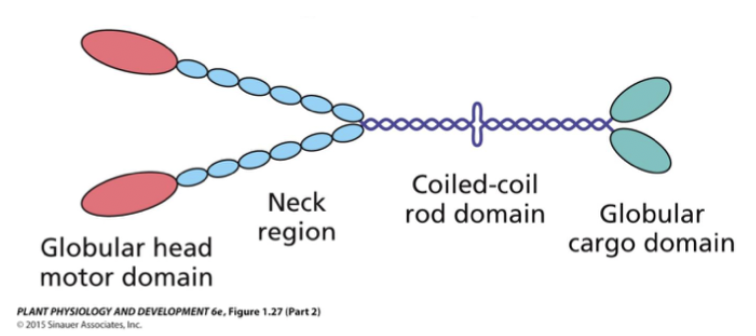
Homodimer is specific red regions.
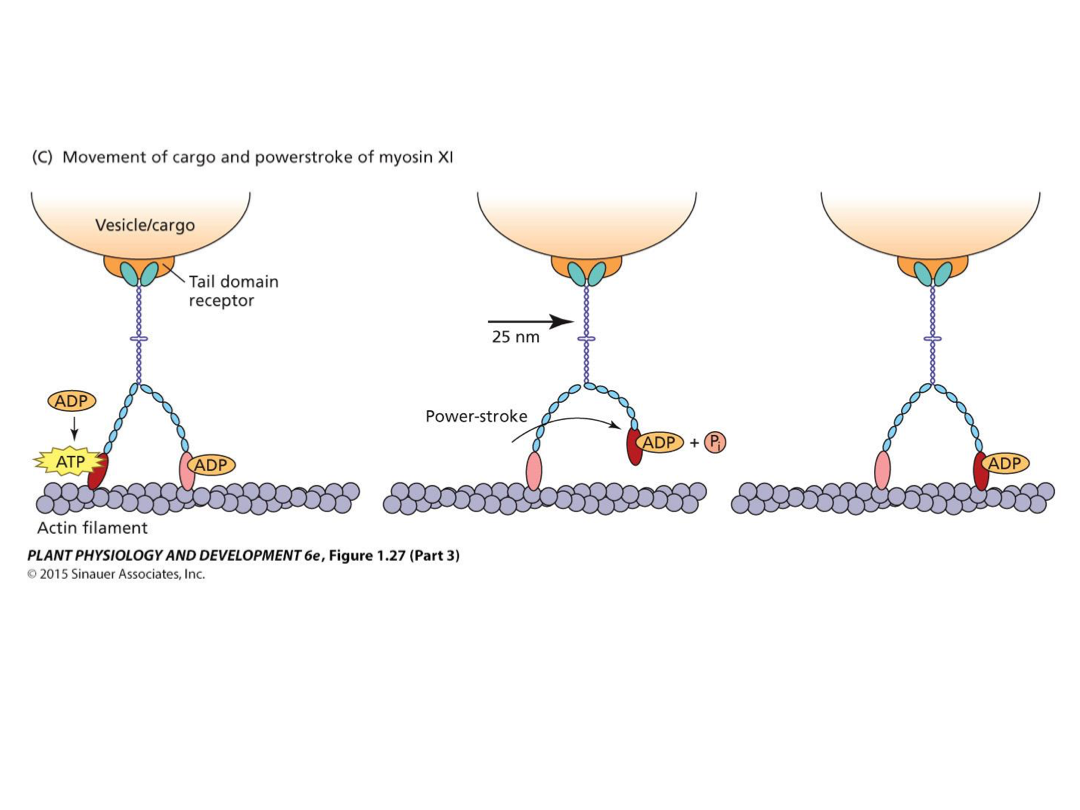
Other domain carries the vesicle. Delivering cargo. Proper function.
Water Relations and Xylem Transport
Water is 80-95% of a plants fresh weight. Limiting resource of productivity. More water typically shows more crop yield. How does it get from roots to shoot?
As CO2 diffuses into leaves, water vapor diffuses out because water loss gradient is larger than that for CO2 uptake.
Oxygen has a partially negative charge - uneven shape of water. Partial charge results in hydrogen bonding (weak electrostatic attractions). Occurs between water and molecules with polar groups (-OH, -NH2).
Single water particles. Covalent bonds. Sharing electrons - covalent bonds. Oxygen has a stronger affinity for electrons away from hydrogen, more towards the oxygen. Oxygen has two lone pairs, open hosts. Partially positively charge hydrogen.
Maximum of 4 hydrogen bonds. Water can have different bases. Solid (too much movement), liquid (larger movements), gas (moving like crazy). How many hydrogen bonds in each 4 solid, 1-3 liquid, 0 gas.
Hydrogen bonding is responsible for many other unique properties. High specific heat energy required to higher temperature of a substance. High latent heat of vaporization - energy needed to separate molecules from liquid to gas phases.
Specific heat capacity: heat energy required to raise the temperature of one unit of mass by one unit of temperature of one unit of mass by one unit of temperature.
Latent heat of vaporization: energy needed to separate molecules from the liquid phase and move to a gas phase. Occurs during transpiration. Latent heat is the energy released.
The above properties buffer the plant against temperature fluctuations. High cohesion means attraction between water molecules, cohesion gives the water high tensile strength. High adhesion means attraction of water to solid hydrophilic surface. For water to be transported, water will be evaporated. Cohesion is between itself, adhesion is between other thing (could be the cell wall).
Surface tension: the energy required to increase the surface area of a gas-liquid interface. At an air-water interface, water is much more attracted to the other water molecules below than to the air. Water has high surface tension, water molecules at the surface have a strong tendency to minimize their contact with air. Hydrophobic air has water droplets form because they want to minimize interactions between water molecule and the air. Specific force which minimizes water touching.
Net force - zero creates a forces against cancelling each other out (inner molecule). Stronger force, droplets
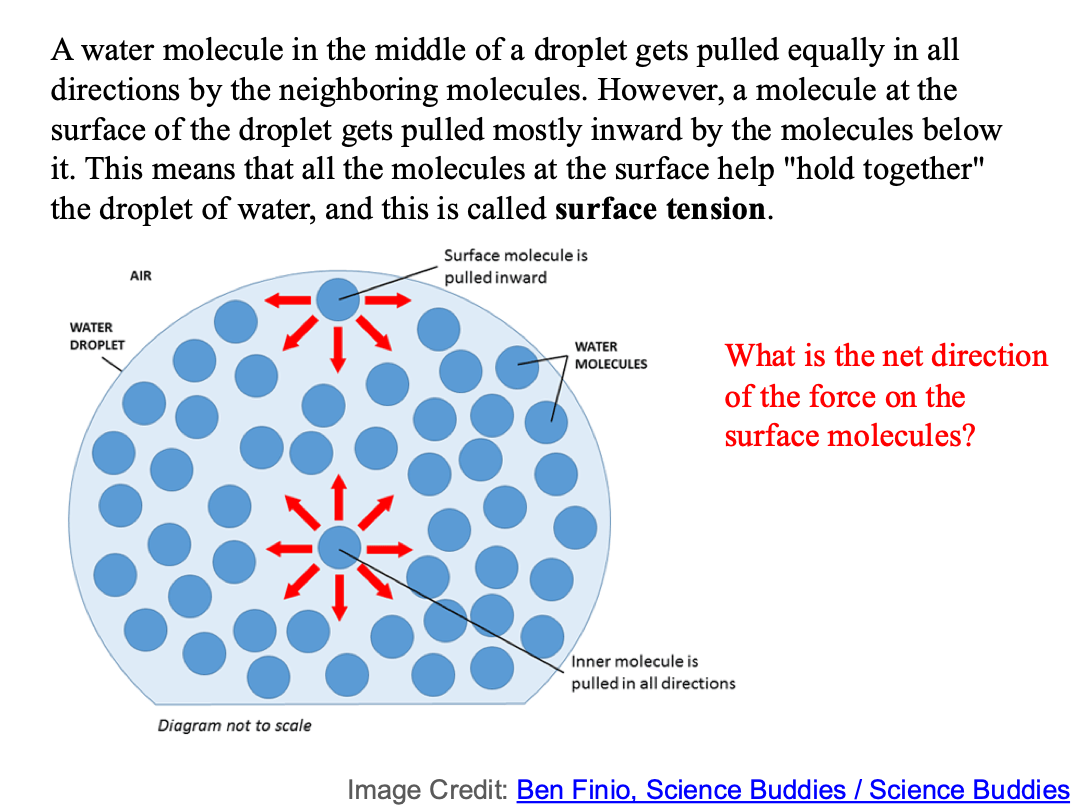
Surface tension is the inner pointing force. If we draw tendril line, force is always perpendicular to pendual line. Unbalanced hydrogen bonds - force generated.
Gas bubbles in water form a spherical shape to minimize interface. Net force of tension is towards the centre. Reduce interface between air and water.
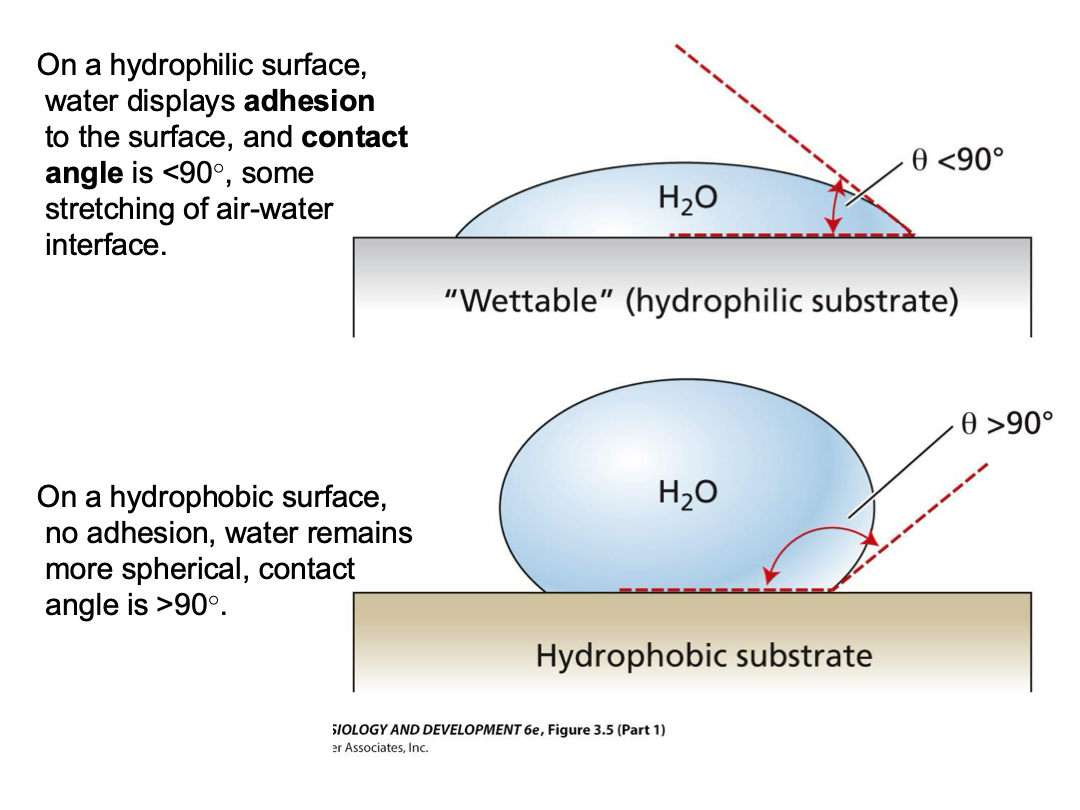

Adhesion interacts with surface. Either hydrophilic or hydrophobic. Hydrophilic can interact - spread or bubble up. Minimize interaction, make that big angle. higher contact angle in hydrophilic.
Cohesion: mutual attraction between molecules to each other
Adhesion: attraction of water to a solid phase (cell wall, or glass)
Capillarity: at equilibrium, the water level in the capillary tube will be higher than that of the water supply at its base. Water is drawn into capillary tube by adhesion and surface tension of water.
Water - strong adhesion to wall of tube (contact angle near zero) stretches the air-water interface, generating strong upward force - causes capillarity (raising of the liquid against the force gravity). Column of water does not break due to high tensile strength of water. Water in tube now experiencing slight negative hydrostatic pressure. Water doesn’t continuously go up when net force evens out with gravity. High tensile strength. Gravity pulls it down but surface tension is stronger.
Syringe: Pull on plunger, push on plunger. Push on plunger - smaller, same direction of force, gonna add up, additional effort to shrink. Pull air bubble makes bubble larger, could break water column. More molecules. Pressure is determined by molecular interaction and molecular density.
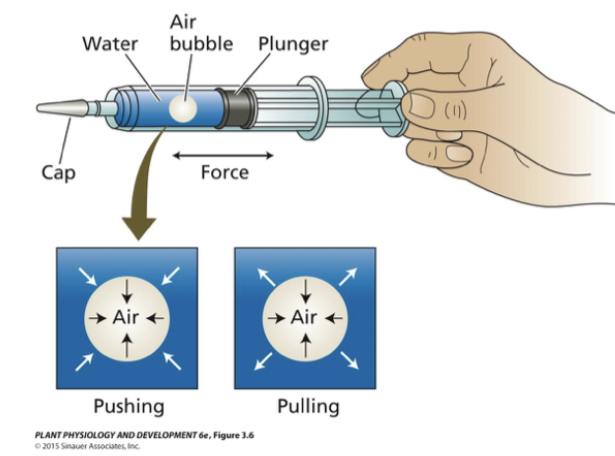
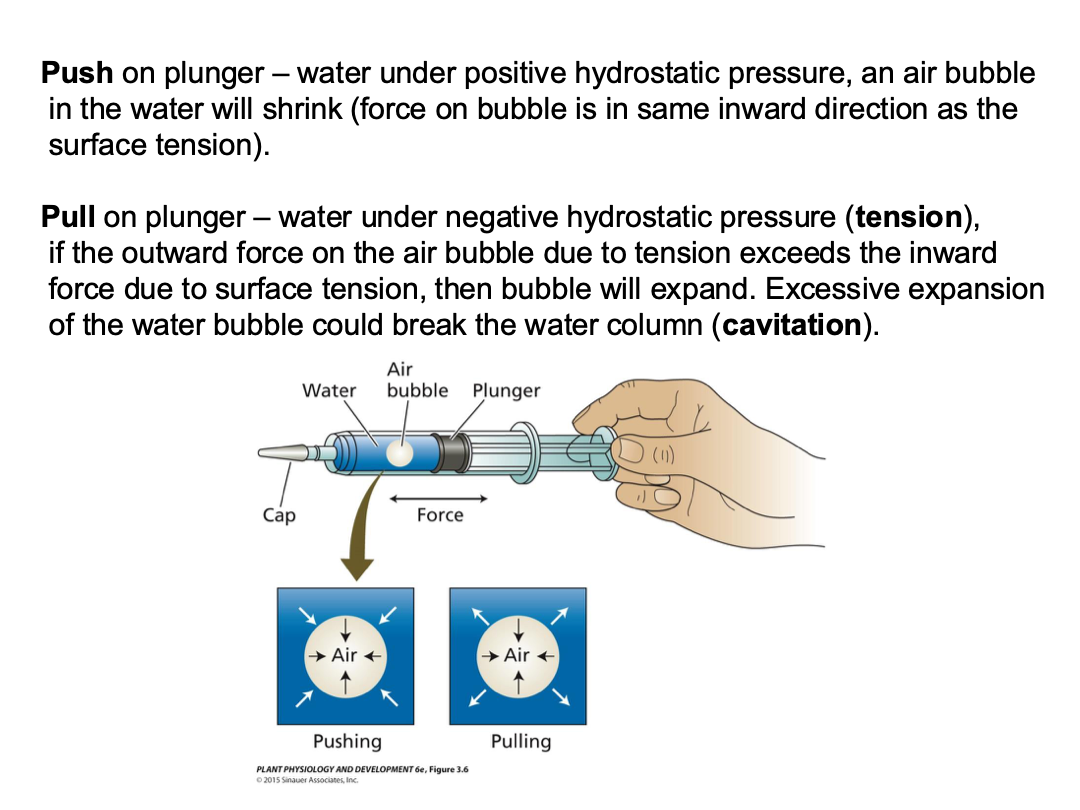
Diffusion: net movement of particles down concentration gradient (driving force). Comes to equilibrium (no more net movement) Initial → intermediate → equilibrium. Rate of diffusion (Fick’s 1st Law) = -diffusion coefficient (total concentration / total distance).
Osmosis: the diffusion of solvent (water) across a selectively permeable membrane (ie. a membrane where solutes can’t readily cross). The driving force is a difference in water potential. Movement across the membrane is facilitated by integral membrane proteins (aquaporins)
Osmotic potential: in soil water is generally negligible, solute concentration are often low (aside from saline soils).
Aquaporins: integral membrane proteins that form water-selective channels across the membrane. Because water diffuses much faster through such channels than through a lipid bilayer.
Gravity potential plays an important role in drainage. higher at higher elevations.
Water potential:
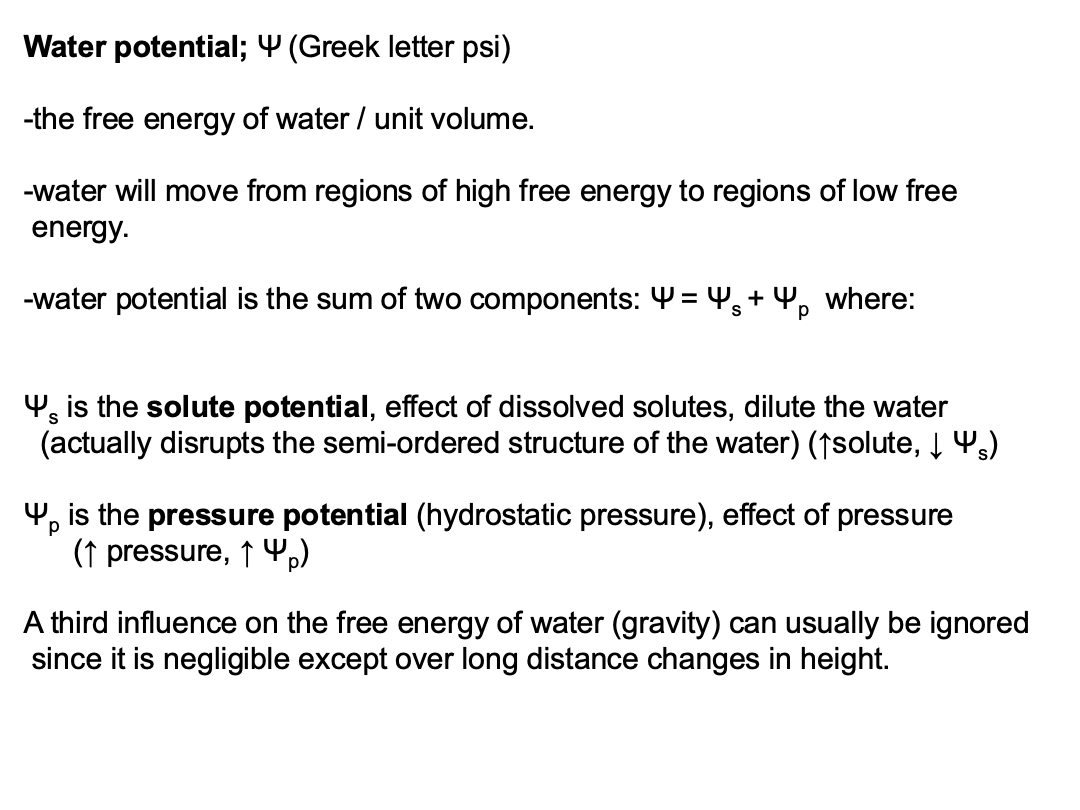
Driving force is water potential. If water potential is higher inside a cell, into the cell. Always moving from higher to lower potential. Increasing solute concentration, you decrease overall potential in a cell. Gravity is not too important with cellular movement.
Rate of transport, flux density:
flux density = (diffusion coefficient)(concentration gradient / distance or size)
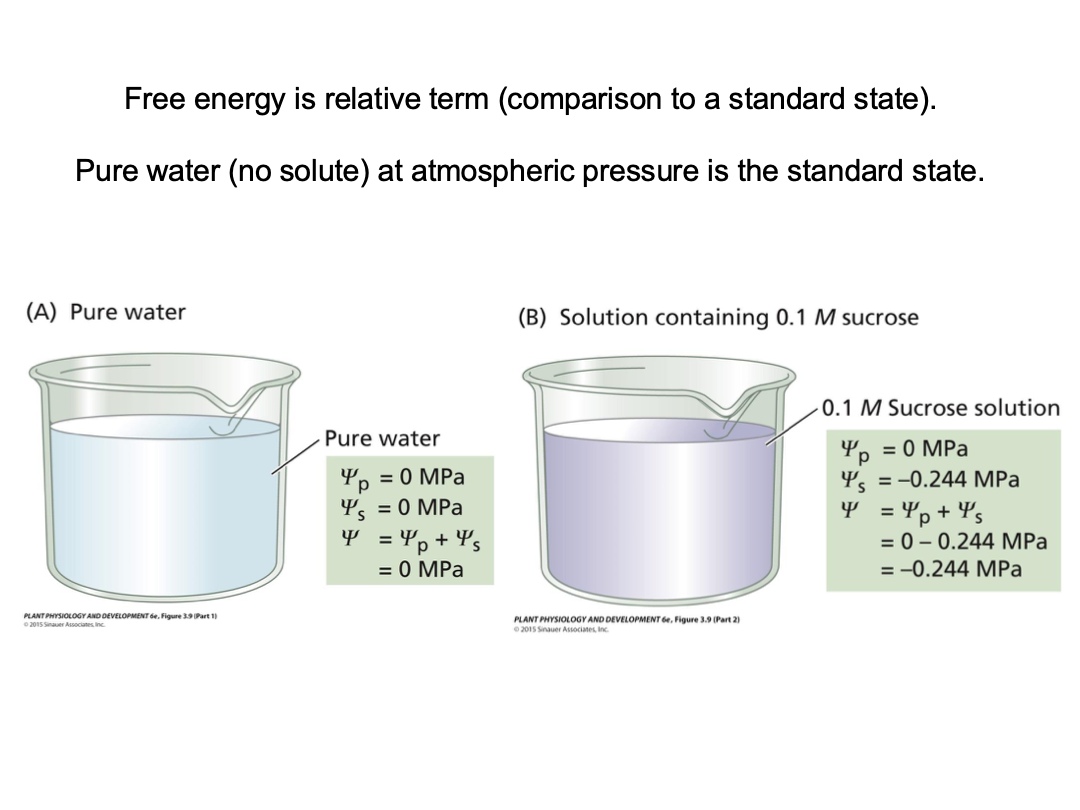
The presence of a cell wall means that plant cells typically experience a positive internal pressure (turgor pressure) - which is important in providing structural rigidity to plant parts without lignin and is driving force for plant cell expansion
Water enters the cell, water potential drives this. -0.732 water potential for sucrose solution - stronger water potential higher. Water moves in, slight increase in volume, resistance by cell wall, pressure increases, new equilibrium.
Major driving force is not solute. Not much water potential change before 90% relative water content (%).
What factors influence the rate of osmosis and the time it takes for a cell to come to equilibrium with its environment:
Size of gradient
Surface to volume ratio of the cell
Stiffness of the cell walls
Hydraulic conductivity (of the membrane): ease of water movement across membrane. Likely at the level of the aquaporins, exist in “opened” or “closed” configurations.
Cell expansion is impacted by water loss since turgor pressure is usually what drives it. Abscisic acid accumulation, solute accumulation increase in water potential, driving the acclimation process.
Cell expansion decreases as water potential falls. Abscisic acid accumulation and solute concentration are activated as water depletes. PS, stomatal conductance, protein and cell wall synthesis, and cell expansion all decrease as water potential decrease.
Plasma membrane hydraulic conductivity impact the rate at which cells gain or lose water.
Long distance travel
Whole plant (long distance) and cell level (short distance). Short distance is micrometers, while long distance is centimeters or meters. We call long distance bulk throw, and short distance is water potential difference.
Stem and root connected by xylem (water) and phloem (sugar), in the ventricle of the plant.
Step 1. Bulk throw
Step 2. Water uptake from root (cellular)
Step 3. Transporting from root to shoot.
Then - long distance, pressure gradient works as a driving force, generative positive pressure in bottom and negative pressure in top.
Soil needs higher pressure, always moves from higher pressure to lower pressure.
Create water stress:
Salty soil (NaCl): higher water content, but high solute as well. Solute concentration is high - directly affects potential. 2 soil particles, water will wrap around it (pressure potential = 0, under atmospheric pressure), since soil is hydrophilic, with interface, you get surface tension
Drying soil: low water content. When there’s more water, it doesn’t have to curve around as much, cuz there’s more water. Air pulls it up.

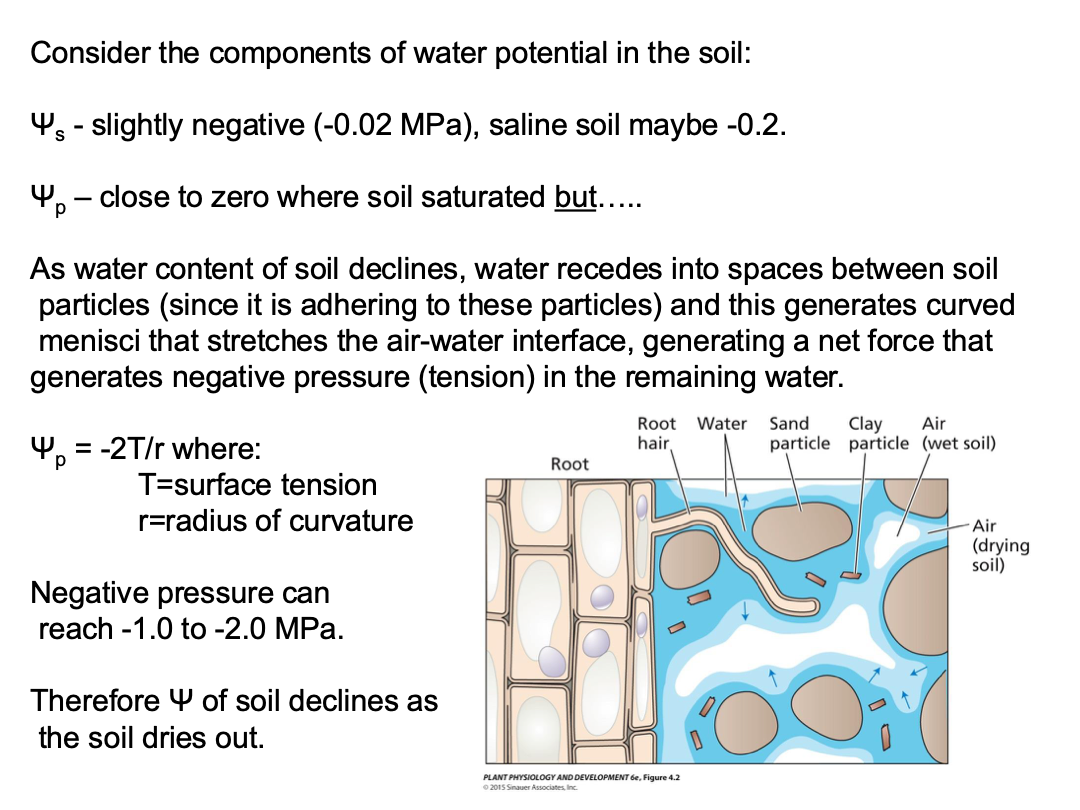
Water moves toward drier regions (near plant roots)
Bulk flow: Water molecules moving en masse in one direction down a pressure gradient (garden hose). Rate is dependent on size of pressure gradient and hydraulic conductivity (ease of movement in the soil). Hydraulic conductivity tends to be higher for sandy soil due to large channels for movement, though it is not constant, it still depends on soil dryness due to air space.
Water absorption by root: critical to max surface area and have close contact with soil particles. Roots continuously grow in fresh soil, root hairs are 60% of total surface area. Apical part of root is highly absorptive, older roots not so much (covered in suberin/hydrophobic covering).
This is to create pressure potential in roots to move it up. root tip ability to transport water.
Primary root comes straight down, lateral is the branches.
Closer to root tip, less suberized, higher rate of water uptake per segment.
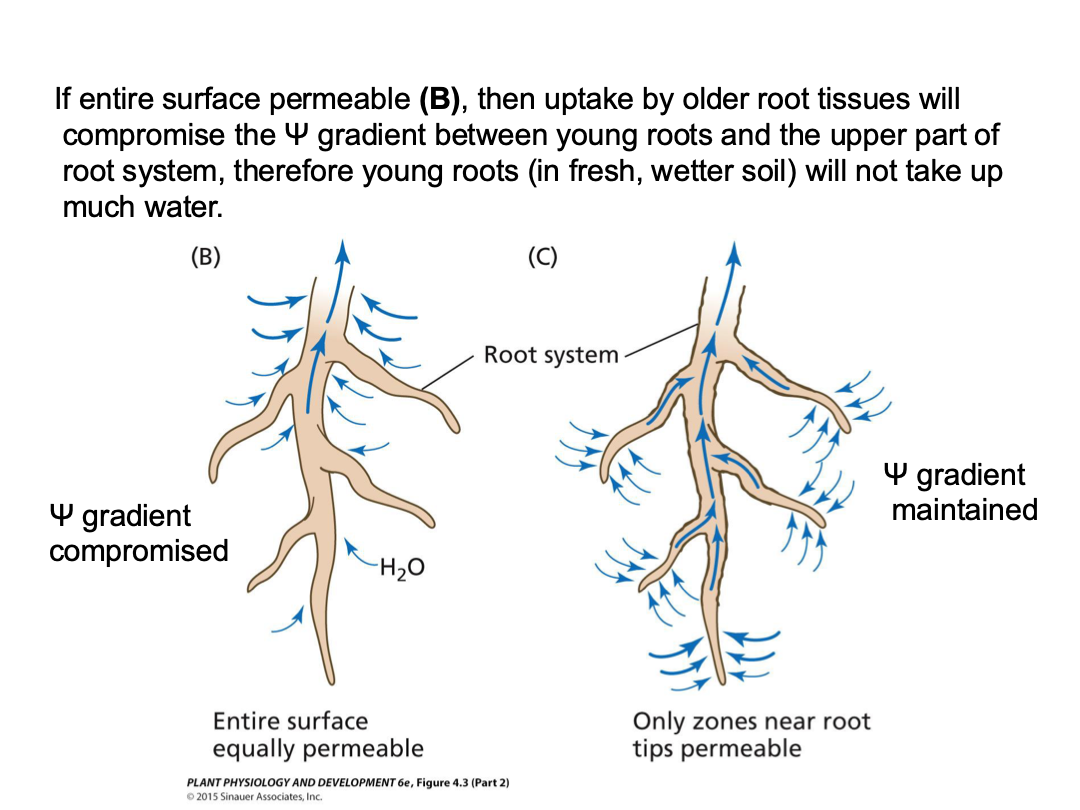
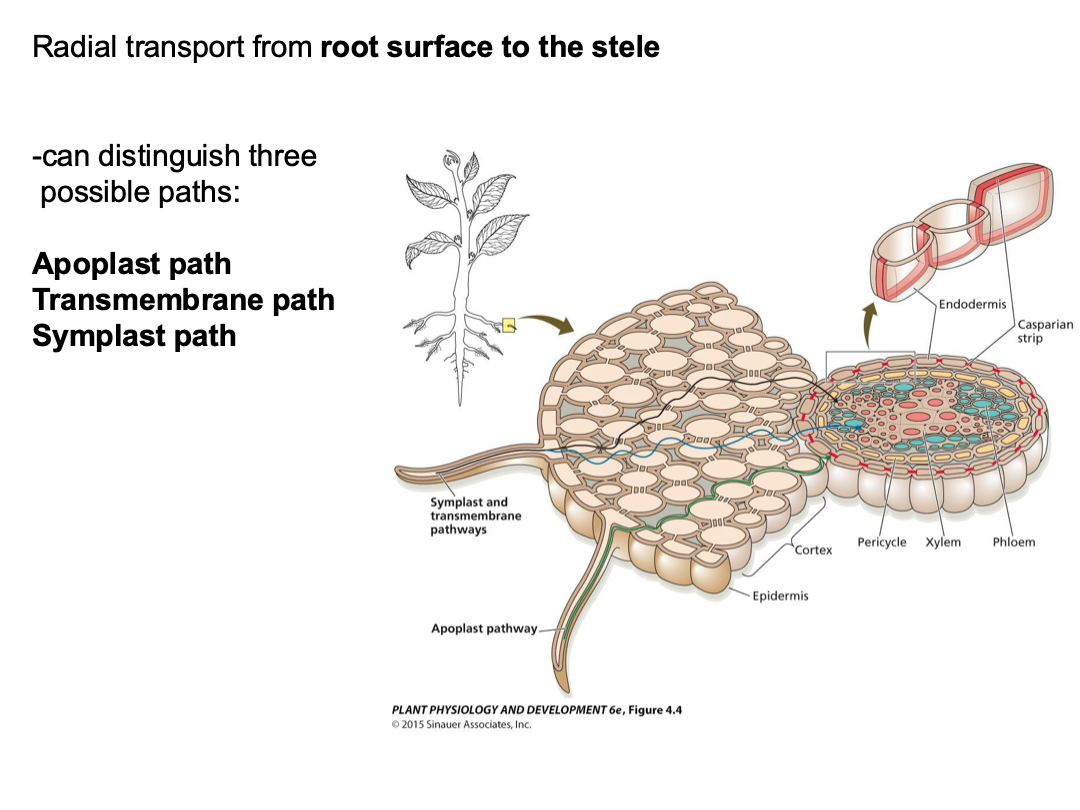
Root has a lot of specialized cell types. Xylem in center of root. Radial transport from surface to xylem. Apoplast is outside of cell membrane, symplast is everything we see in plasma membrane. Plasmodesmata connects the 2 cells, all plant cells connecting. Water needs to pass symplast membrane to enter cell.
Apoplast is only in endodermal cell. Outside of PM, apoplast is blocked, relies on channel. Suburin is also known as the Casparian strip. Stuff needs to pass at least one membrane, because water inside soil is not just water, there’s minerals, and some are very toxic (aluminum). You need a transporter on the membrane. Can only import important minerals, avoid toxic minerals that don’t have transporters.
Apoplast is the continuous system of cell walls. Symplasm is entire network of cell cytoplasm interconnected by plasmodesmata (water travels across root cortex via plasmadesmata). Transmembrane pathway is the route by which water enters a cell on one side, exits the the cell on the other side, enter the next in the series, and so on.
Water MUST cross endodermis
cell layer enclosing stele
the radial walls of these cells are filled with suberin
blocks the apoplast pathway so water needs to enter the symplast to go further
minerals have access to xylem since membrane transport is required to enter symplast
Once crossed the suberin, water reaches the xylem.
Tracheids and vessel elements: both have thick secondary cell walls, both dead at maturity, hollow cells (just primary and secondary cell walls), both have pits in side walls. Gymnosperms have only tracheids, while angiosperms have both. Low resistance to water transport.
Tracheids much longer. Narrow diameter, tapered. Tapered ends overlap and generate file of cells. Overlapping pits (pit hairs) also allow for lateral movement
Vessel elements: wider opening. Shorter, wider diameter. Near open ended walls, stack end-to-end to generate file of cells called a vessel. Pit pairs. Lower resistance path than seen in tracheids.
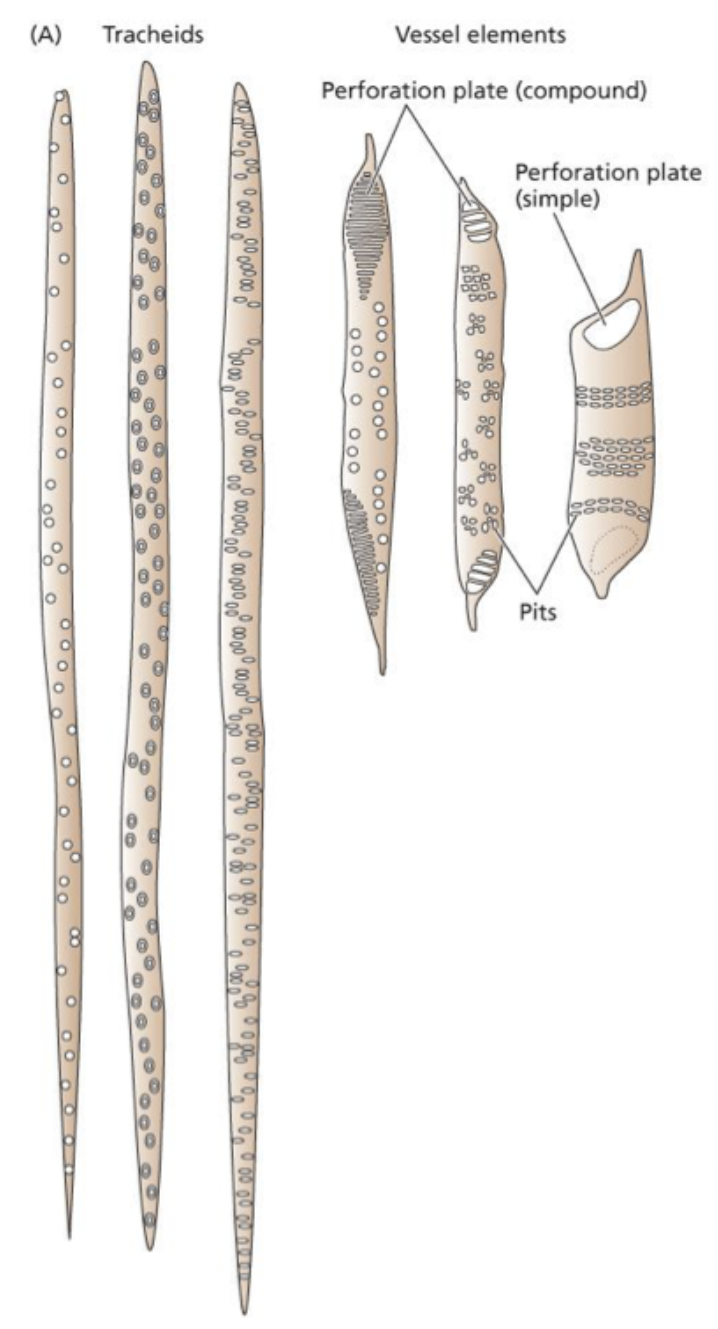
Water moves through xylem by pressure-driven bulk flow. 100m tree, pressure difference has to be about 2 to 3 MPa.
More positive pressure at the base has been measured (root pressure) when water transport is low and not occuring. At night, little water is lost through transpiration. Water flow through xylem to replace that being lost. Mineral uptake continues and accumulates at the base, increases huge water influx. They stop stuff by changing the soil concentration. uptake of minerals increases soil concentration, decreasing soil potential.
Water imbalance (too much) can result in leaf guttation (dew drops), water being forced out onto leaf surfaces through specialized pores at vein ends called hydathodes. Developing negative pressure in the leaf tissue is important for driving water.
High transpiration - pressure gradient is built through negative pressure at top of plants. Negative pressure pulls up on the water column and can withstand breaking due to the large cohesive forces of water. What generates tension? leaf has a lot of air space, lots of surface area for evaporation of water from cells.
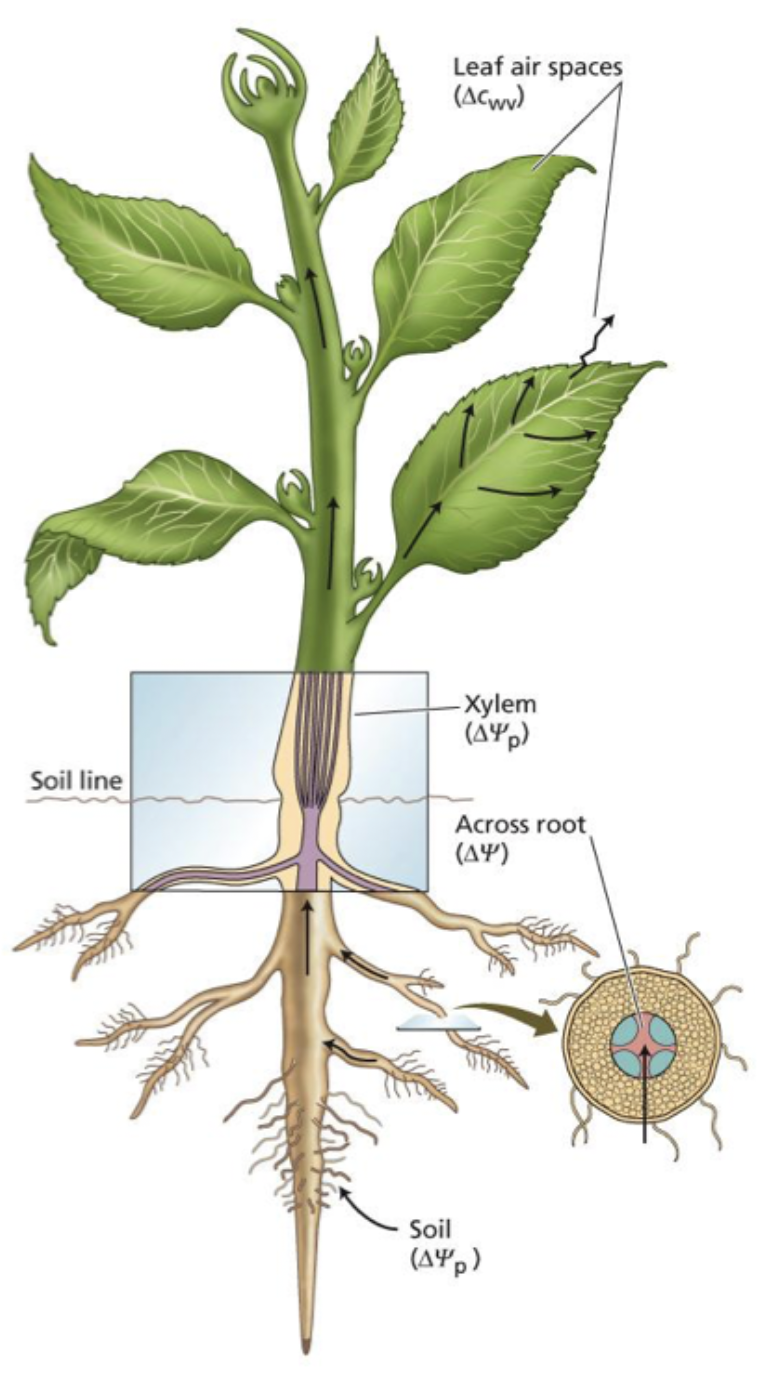
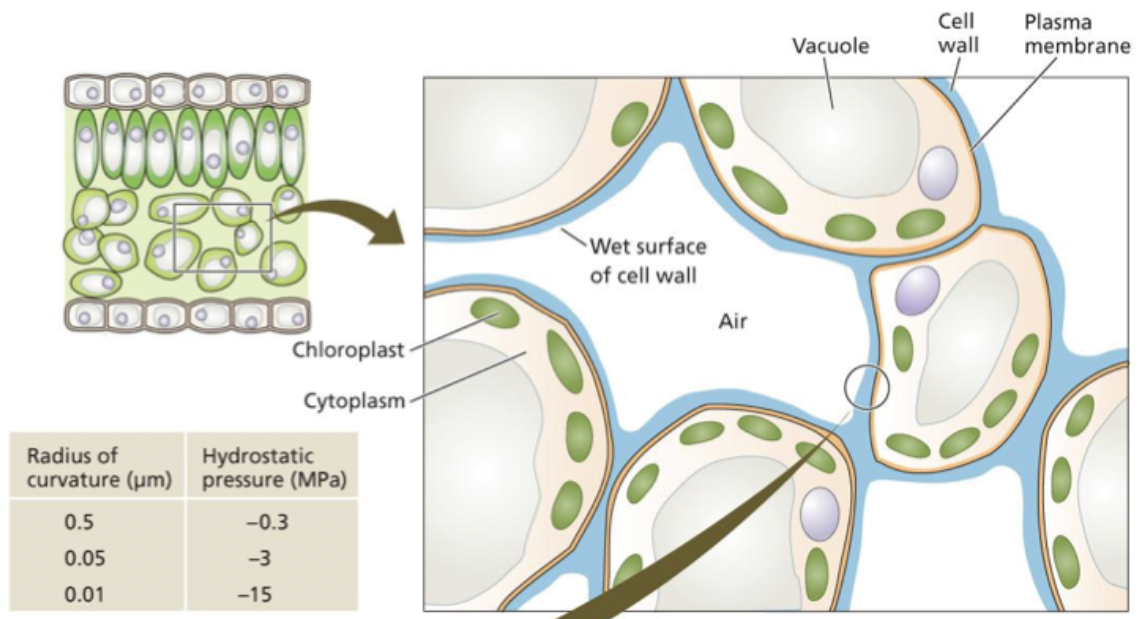
Epidermis and mesophyll cells. In between mesophyll cells you have air space. You need room for carbon dioxide. Inside the tissue. Cell wall made of glucose mostly cellulose.
Cell wall is a matrix of cellulose microfibrils. Water adheres to this matrix. As water content declines, increased curvature of air-water interfaces (just as occurs in the soil matrix) causes tension. Tension establishes the sufficient pressure gradient needed for xylem transport.
Cellulose structure - the lines crossing. Cell wall saturated by water has a pressure potential of 0. Water level will decrease during day time. Water evaporates, cell wall hydrophilic, we see a curved interface, leading to surface tension. r=0.5 is chill, r=0.1, come on in water film.
Potential pressure = -2T/r, T = surface tension, r = radius of curvature.
Tension-Cohesion model for xylem transport:
The combination effect of water adhesion and surface tension generate the negative pressure potential to pull water up.
The cohesion is the transmission of that tension all the way down to the xylem to the roots. Cohesion maintains water column in xylem.
Halophytes: plants that grow in saline environments have very low pi s - lowering overall pi. accumulation of solutes in cytoplasm.
Biochemical and Physiological Aspects of Photosynthesis
Oxidation state: total number of electrons present in that atom
Assigning oxidation states:
Free element = 0
Hydrogen generally has an oxidation state of +1
Oxygen generally has an oxidation state of -2 in compounds
Oxidation state of carbon can vary widely, from -4 to +4
The sum of oxidation states is equal to zero for neutral compounds
Oxidation = an increase in oxidation state
Reduction = a decrease in oxidation state
OIL RIG - oxidation is loss, reduction is gain
There is no net change in the number of electrons in a redox reaction. Direct and indirect electron transport (electron shuttles)
Life on earth is dependent on energy from sun, as photosynthesis harvest it into chemical energy
3 CO2 + 6 H2O → C3H6O3 + 3 O2 + 3 H2O
over all gibson free energy = 115 kcal/mol of CO2 fixed. Highly endothermic reaction, requires input of energy. A light-driven process, a redox process, a gas exchange process. G is positive, meaning it is endothermic → requires an input of energy to run, will never happen spontaneously. Light provides the energy.

Light reaction and calvin cycle: happen at different compartments of chloroplasts. Chloroplasts has double membrane. Very tightly next to each other. Thylakoid membrane. The light reaction occurs on the thylakoid membrane. In the stroma. Check back in on what thylakoid and stroma mean. Light reaction gets light and water, generates electrons and NADPH / ATP. Lose of oxygen. NADP+ comes in and gets converted, very important pass of electrons from water. Disrupting either cycle, NADPH or ATP cannot be recycled back into making more ATP.
Light
Light is electromagnetic energy. Waves come in different wavelength and frequencies, and particles come as packets of energy called photons. Photon energy is inversely related to wavelength.
Magnetic field component, direction of propagation, wavelength and electric-field component.
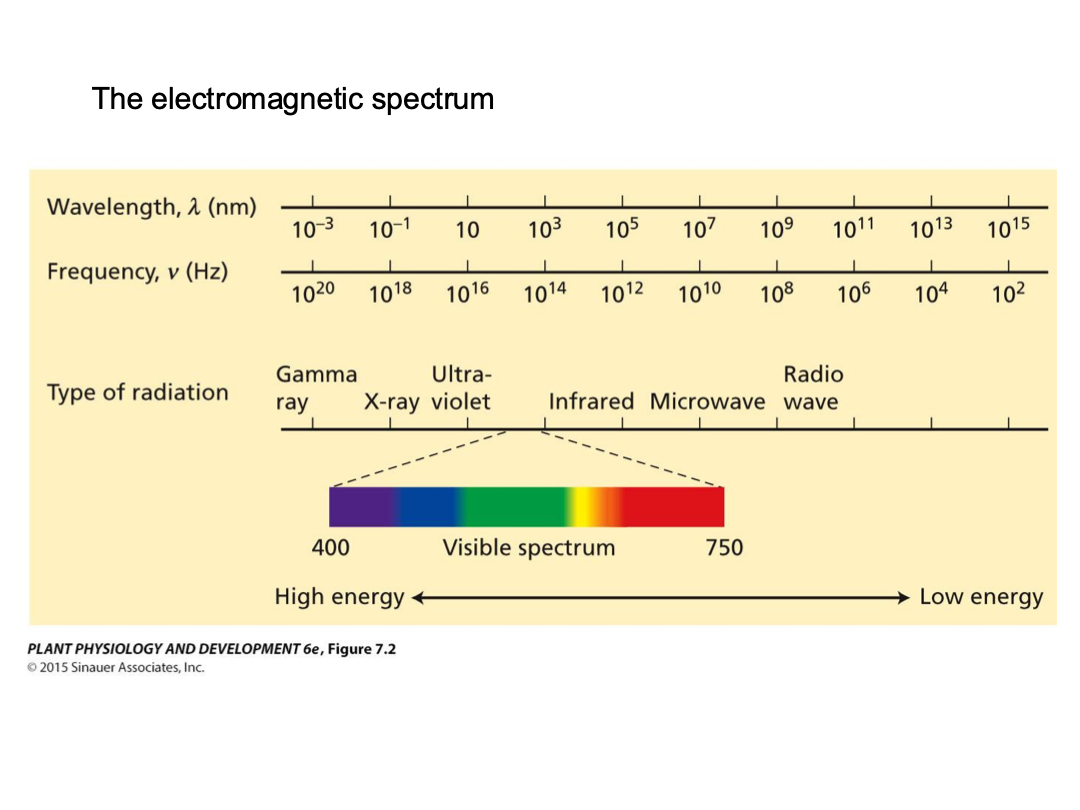
Chlorophyll a, b are the main photosynthetic pigments. Complex porphyrin-like ring structure with central magnesium. Hydrophobic tail to anchor chlorophyll in the thylakoid membrane. Absorption maxima in the blue (430nm) and red (660nm) regions. After chlorophyll absorbs light, it becomes excited and the compound has a much higher energy.
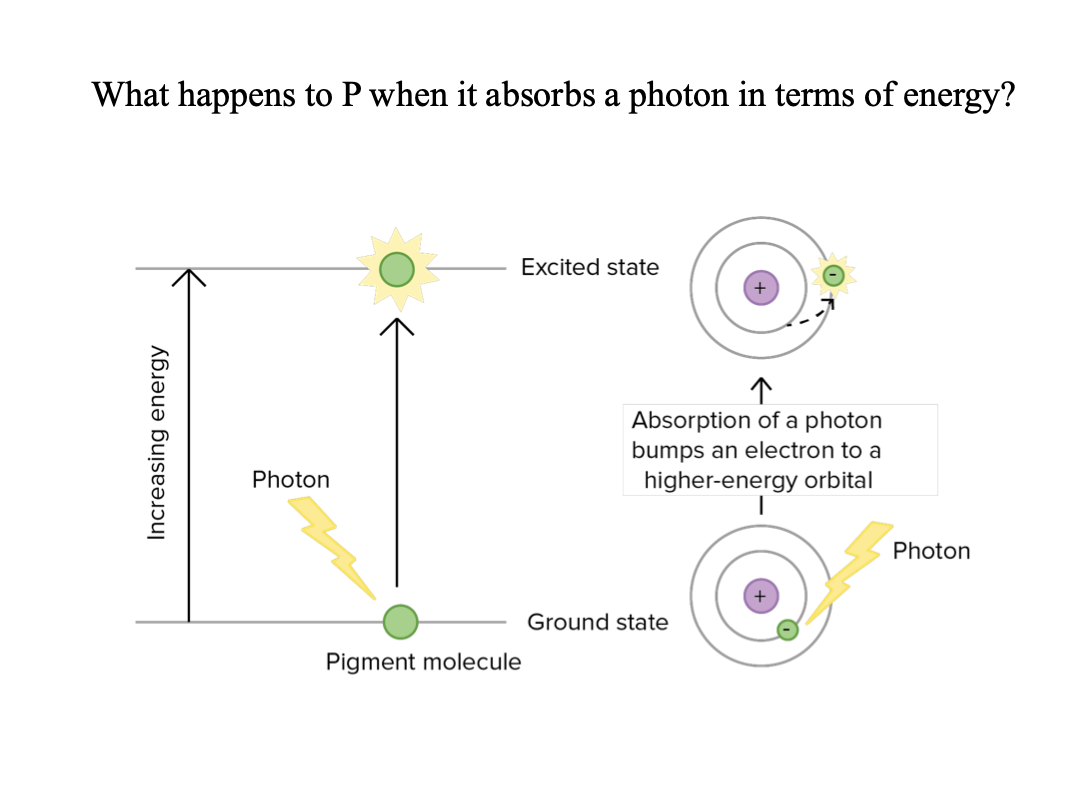
Is the energy/wavelength enough to move the electron - E- can be pumped out if stuff is too strong. E- can be pushed either way by blue and red light energy.
1 → 3 blue light (higher energy)
1 → 2 red light (farther distance)
Molecules contain much higher energy than we hope.
Chlorophyll ground state + photon → Chlorophyll excited state
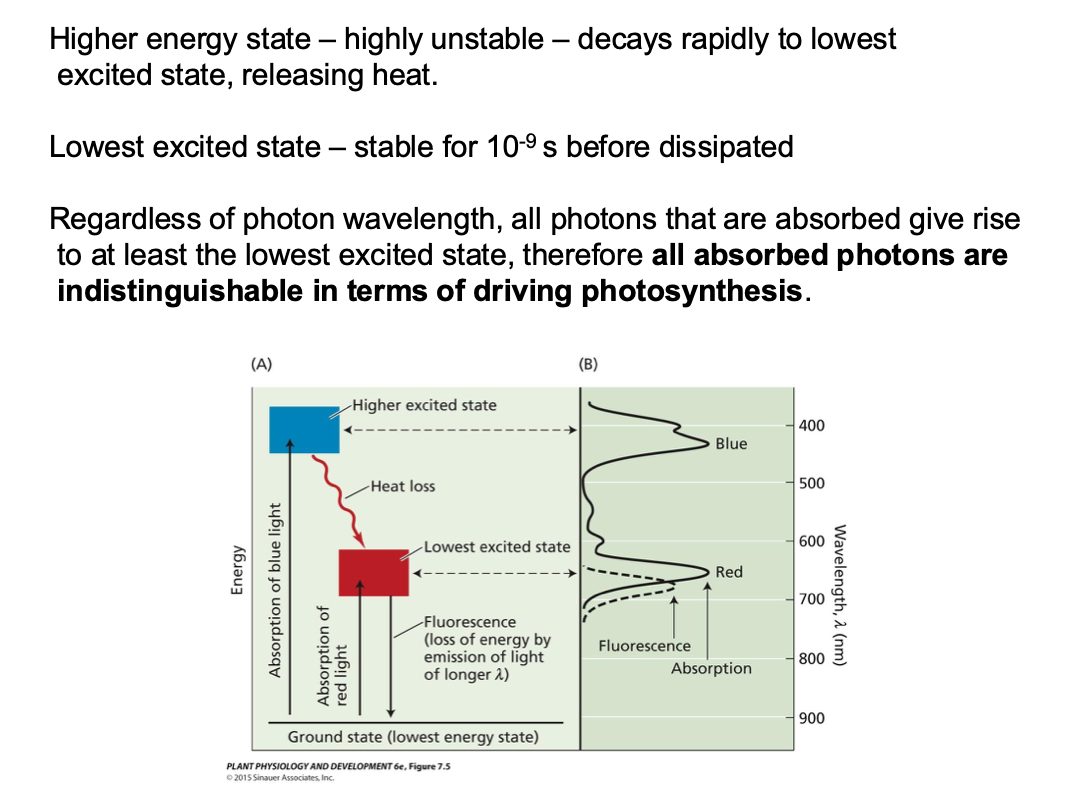
Light of fluorescent always has a higher wavelength. Energy is lost as heat. Fluorescence always has lower energy because of heat loss. Detect and everything.
Four routes to dissipate energy while returning to ground state:
Heat release
Re-emit photon of longer wavelength (fluorescence). Chlorophyll emits red fluorescence.
Energy transfer to another chlorophyll molecule (resonance transfer)
Photochemistry (electron transfer, chemical energy transfer)
3 and 4 must occur extremely rapidly to compete with 1 and 2.
Antenna chlorophyll - moves out energy channel, passing along
Reaction center - pair, “special pair”
Photosystem - something inside chloroplasts with chlorophyll and proteins, driving photosynthesis to be practical. 100s of chlorophyll need to work together. 100s of different chlorophyll, brought into antenna.
When energy reaches reaction center, it’s not passing to anymore chlorophyll.
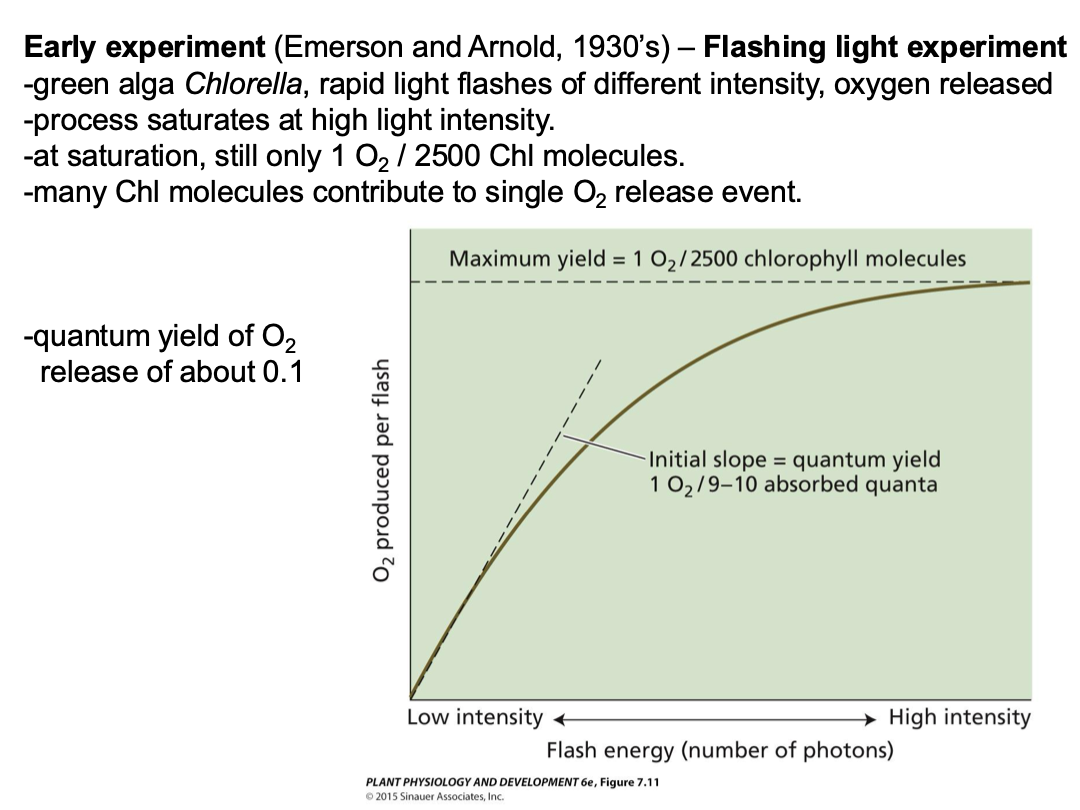
Shine light at different intensities. 2 major values - slope of curve and quantum yield (how much oxygen can a single photon use).
about 0.1 oxygen produced per photon yield. need 10 per single oxygen. Higher intensity has PS level off, something else then becomes a limiting factor, not light. 2500 for O2 you need hundreds of different molecules. 100 of chlorophyll.
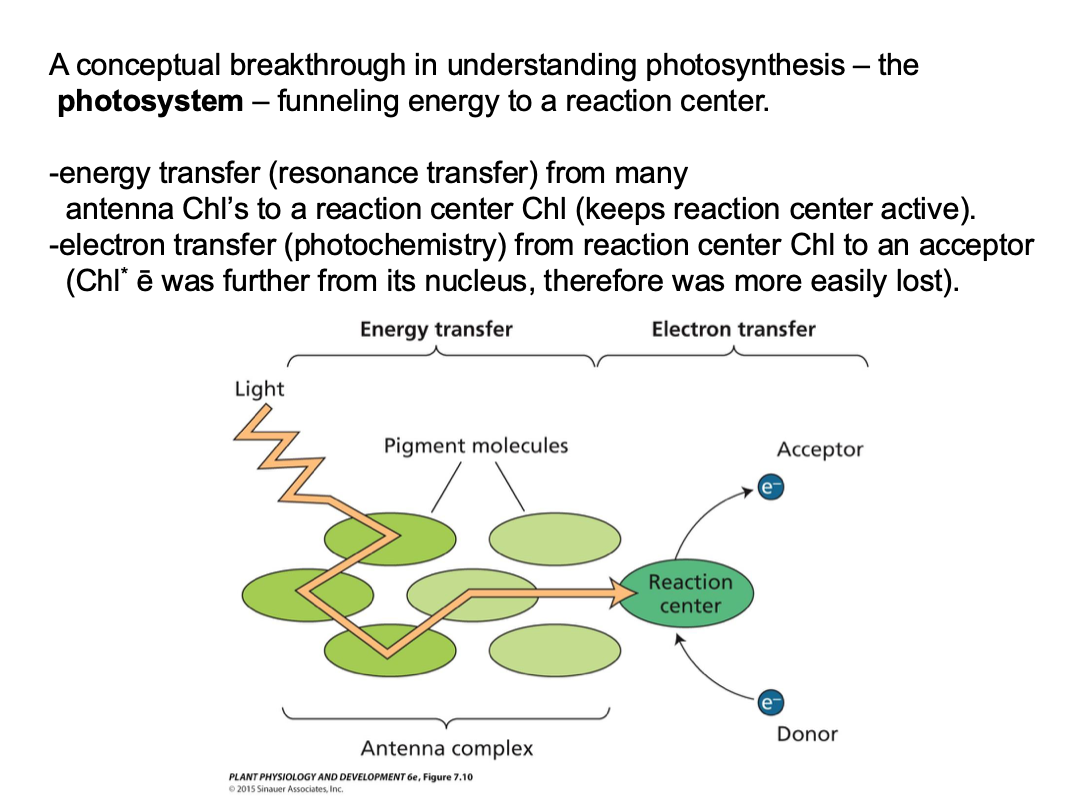
Photosystems contain so much. Associate with the thylakoid membrane. Chlorophyll can do a lot. Passing to the donor, accepting the donor.
1 O2 / 2500 Chl
there’s about 300 Chl associated with a photosystem
Each reaction center must operate 4 times to generate one oxygen gas.
2 different photosystems working in a series.
300 Chl per photosystem x 4 trials x 2 photosystems = 2400
Need 4 electrons
Enhancement experiment:
Look at rate of PS at sub-saturating light intensities of different wavelenght
Emerson enhancement-effect: the rate of photosynthesis when red and far-red light are given together is greater than the sum of their rates when given separately. More effective light use when both wavelengths were given. Two photosystems cooperate and work more efficiently.
700 nm and 600 nm then add = photosynthetic rate is higher than just the sum.
PSII (P680) has a 680nm absorption maxima
PSI (P700) has a 700nm absorption maxima
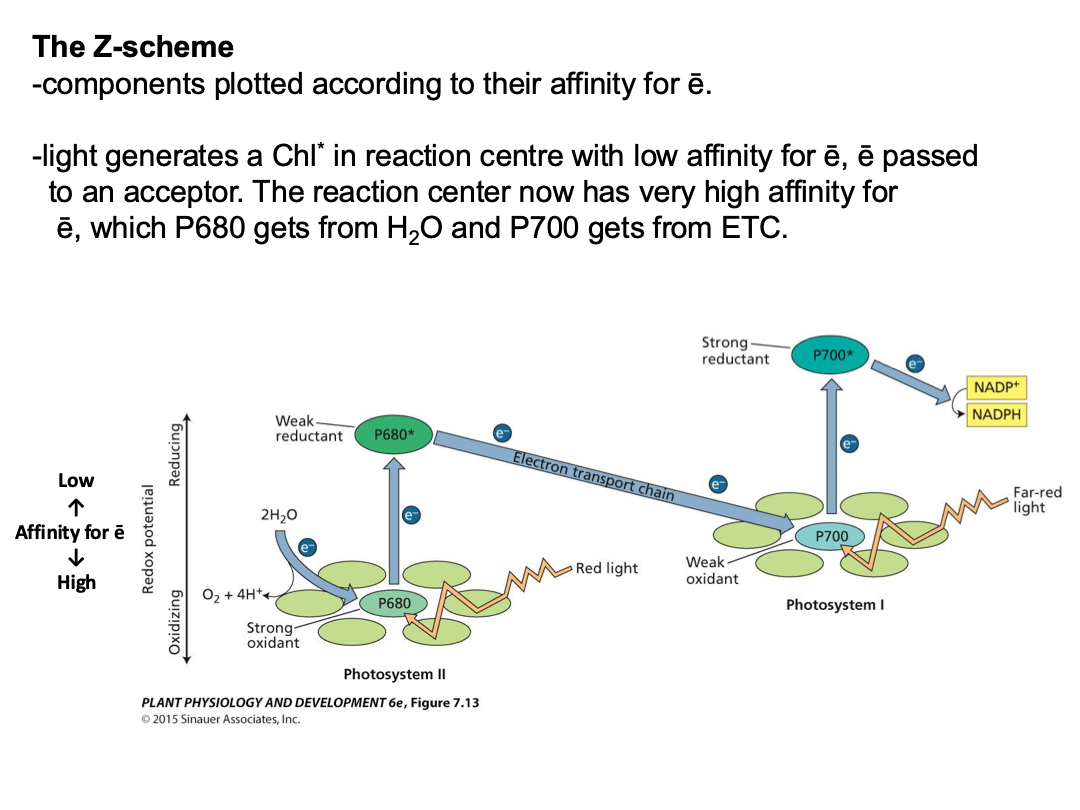
Both PS have antenna, make up electron transport chain. Initial step is water, splitting oxygen, and water becomes the ultimate electron provider.
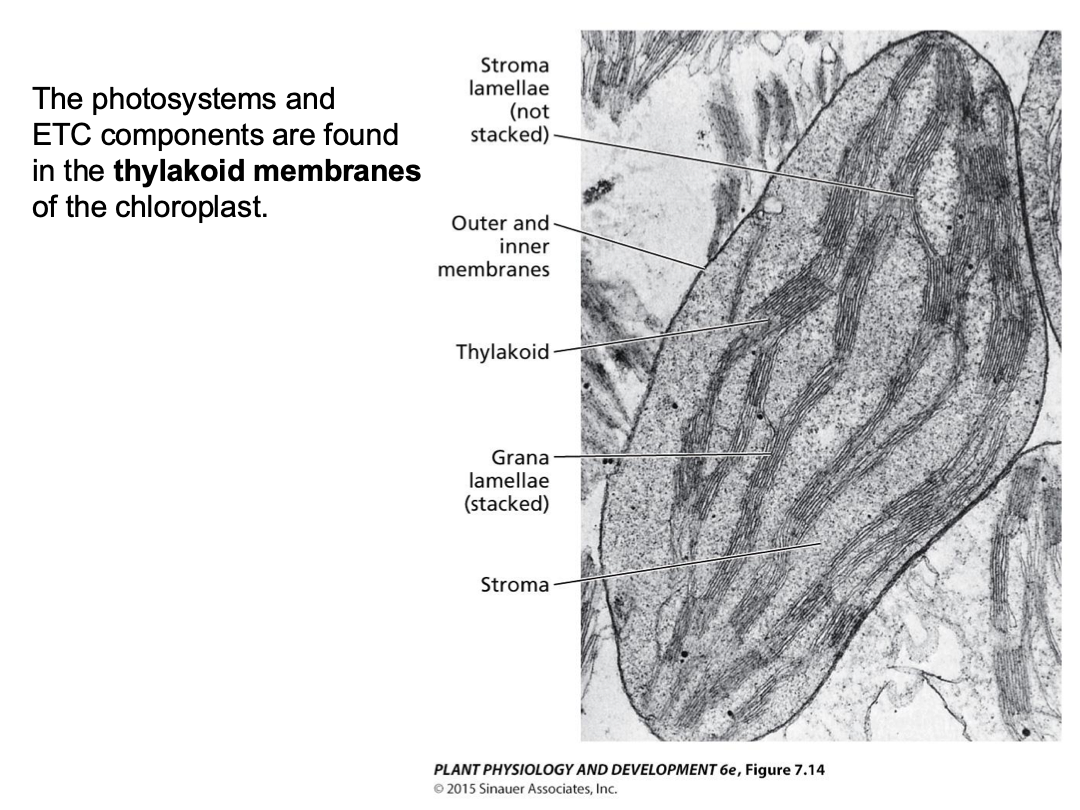

Grana lamellae. Photosynthesis and working through the stack.
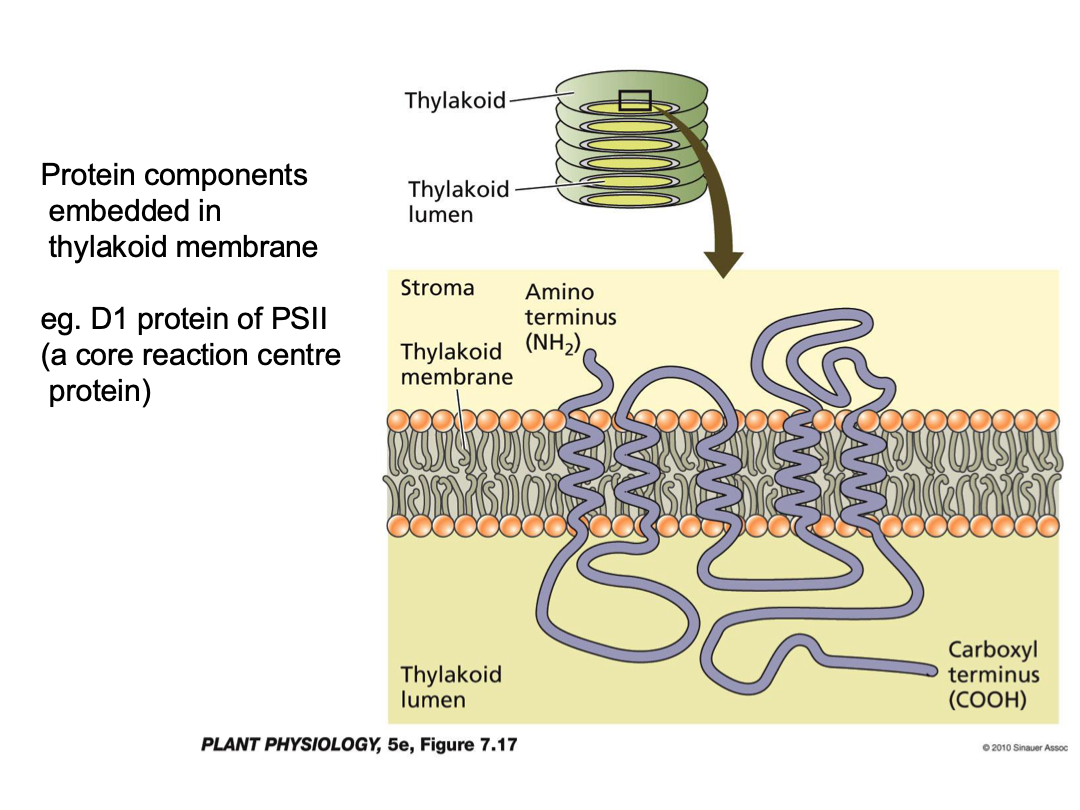
Transmembrane proteins.
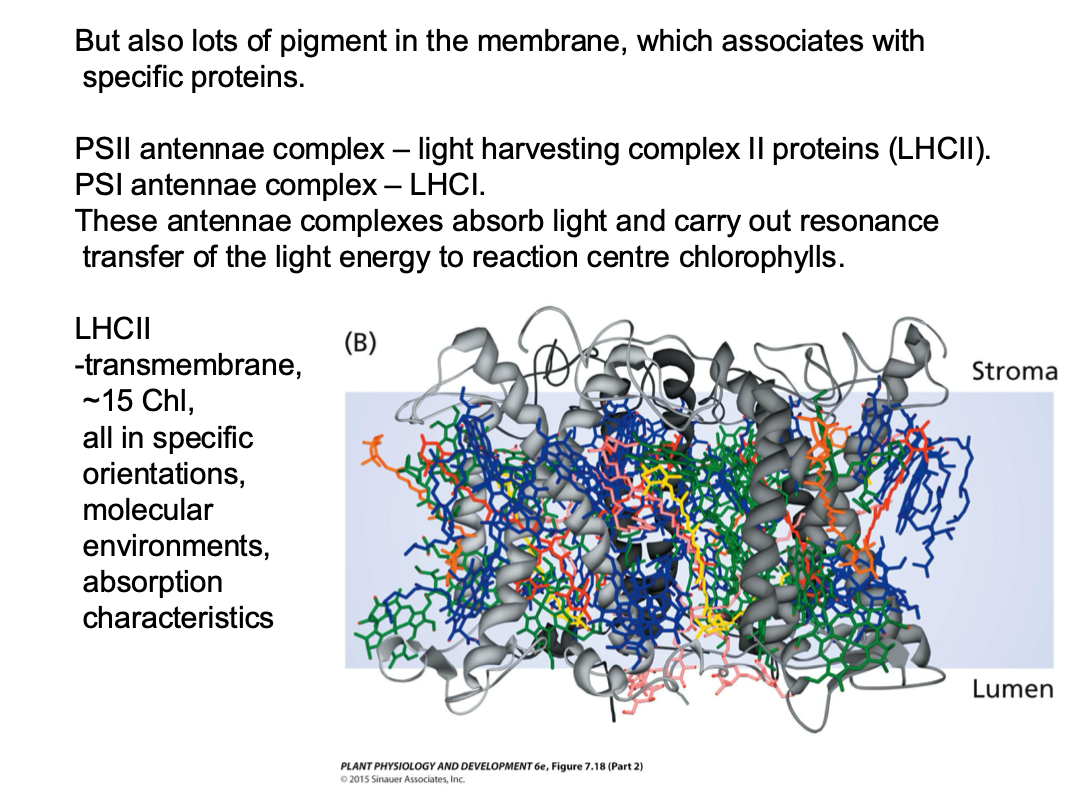
All the colours are chlorophylls all uniquely connected to the protein. Same for both photosystems. Orientation determines absorption.